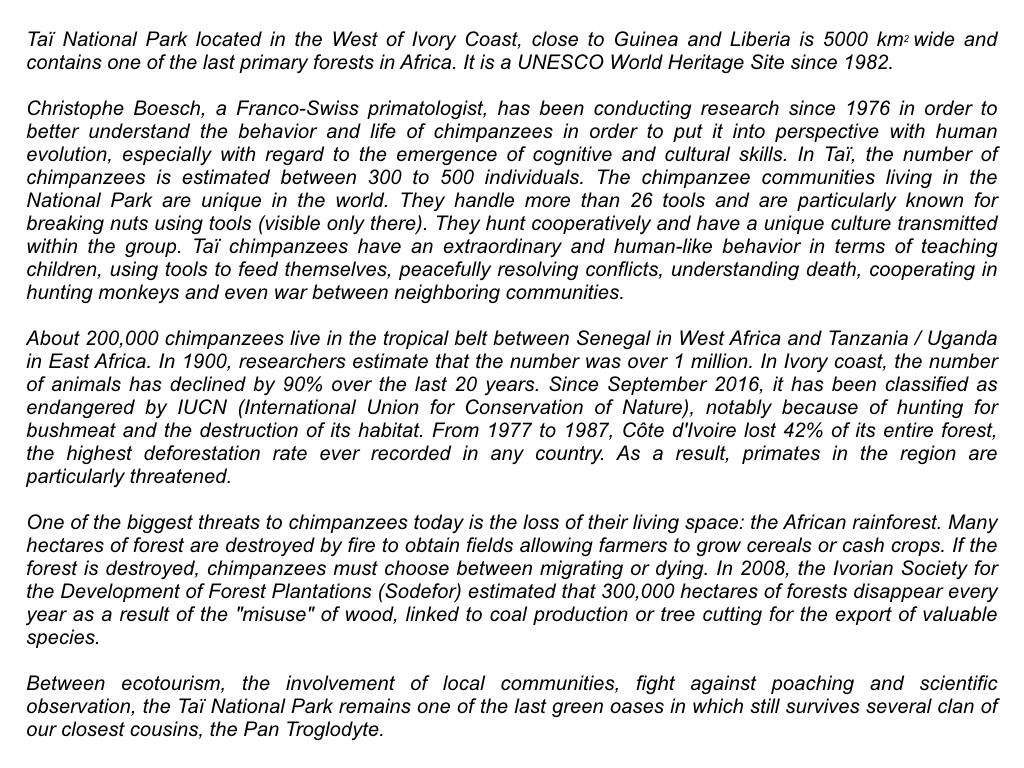


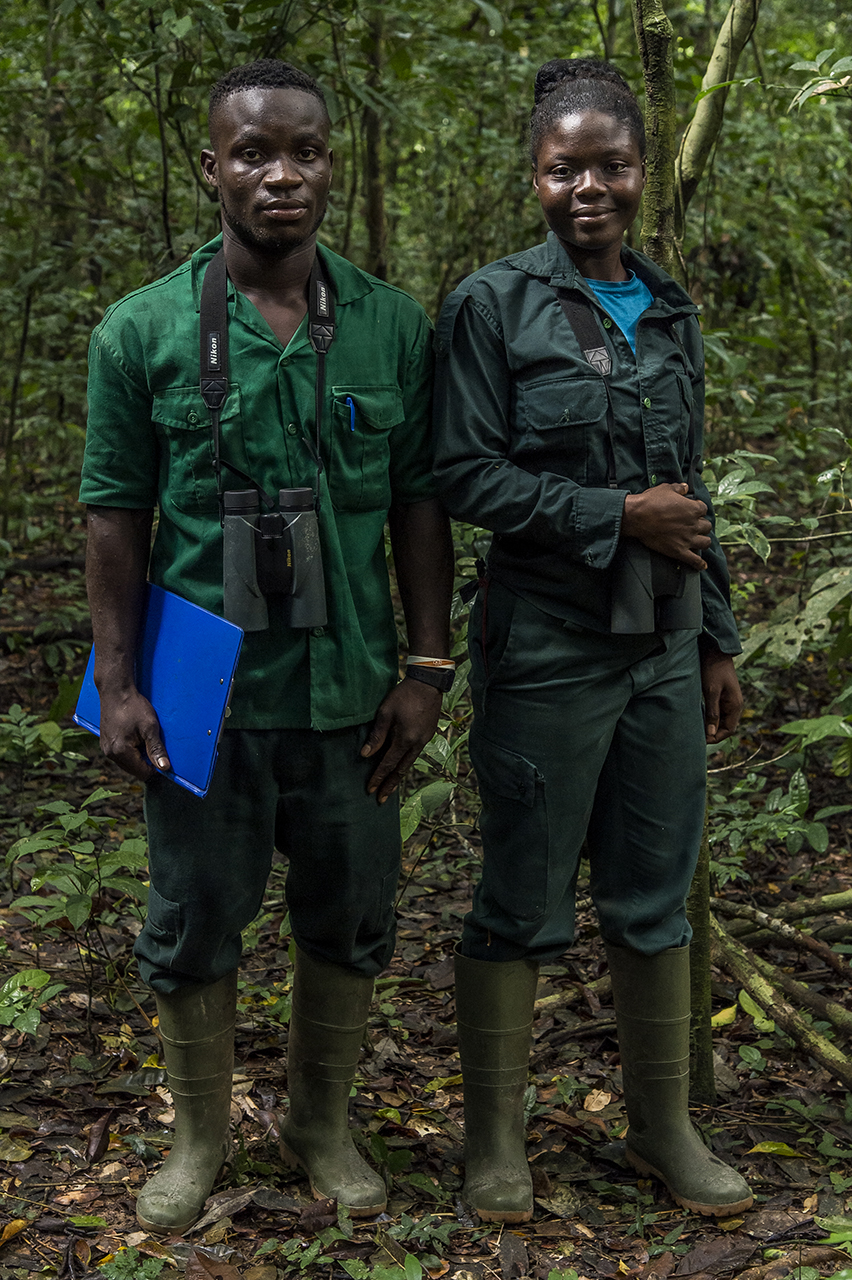
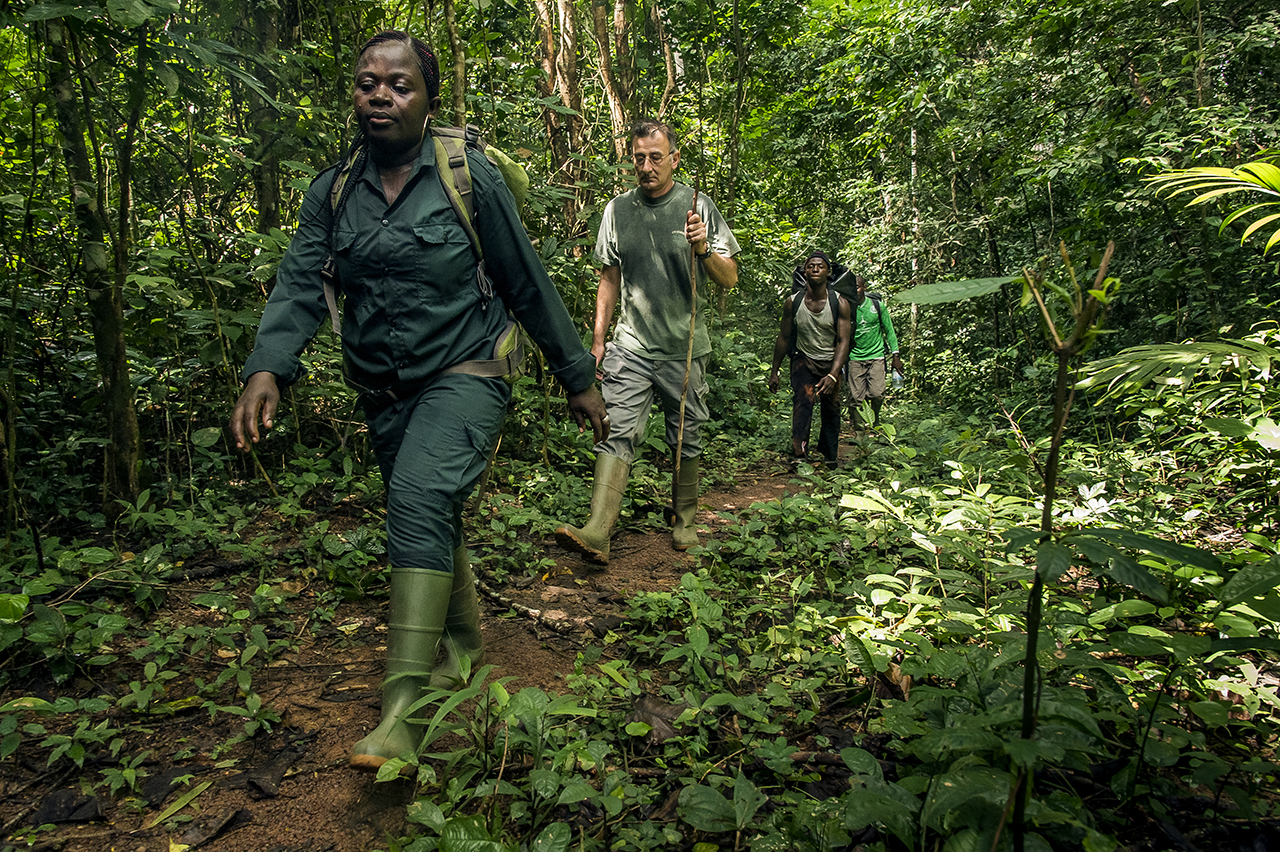
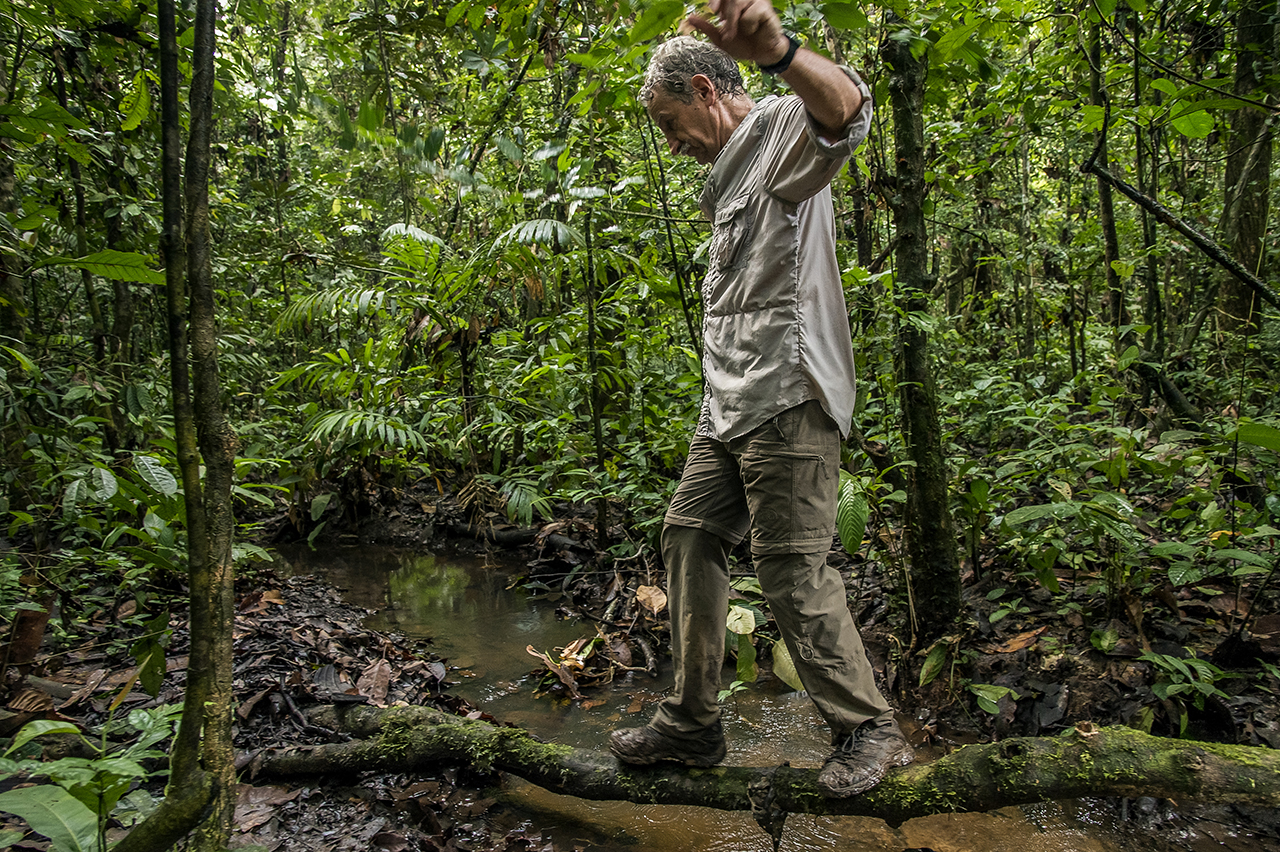
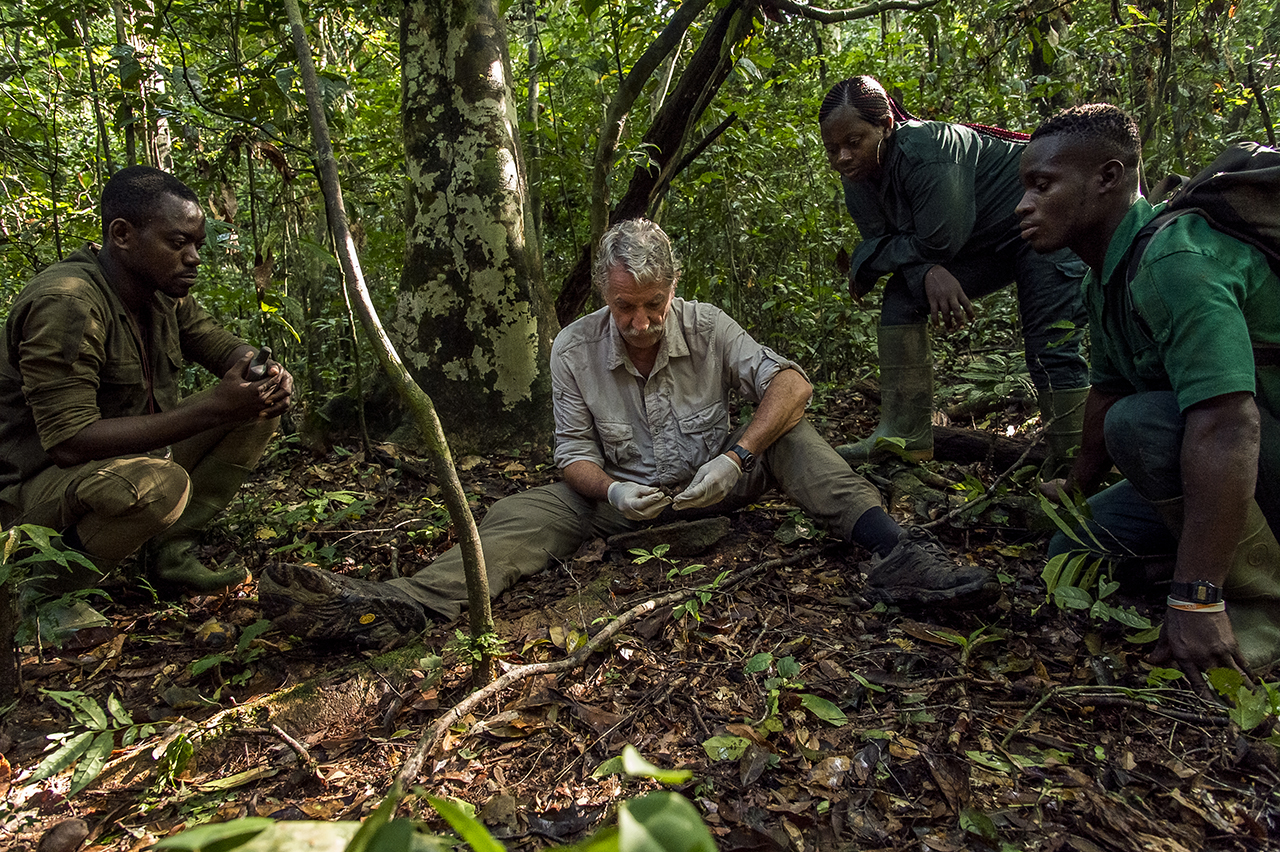
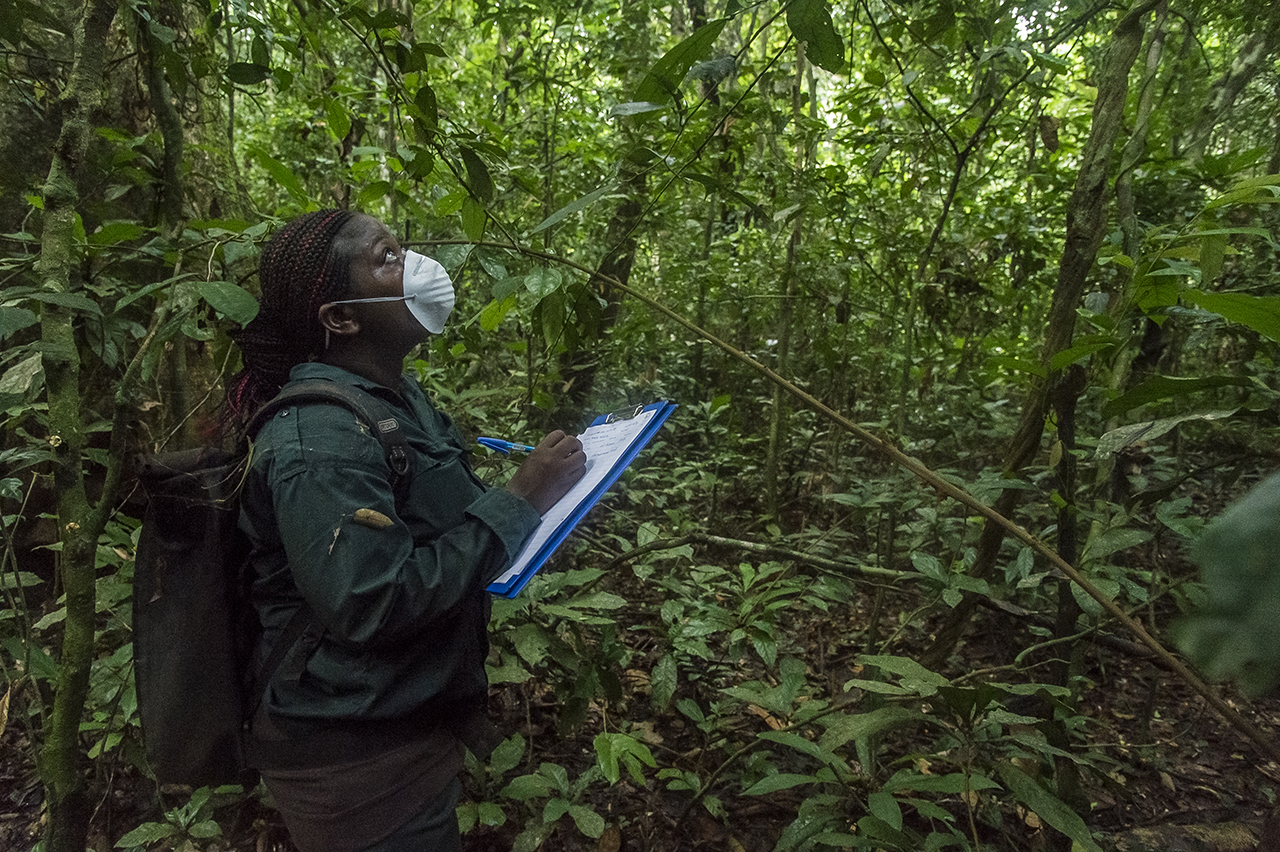
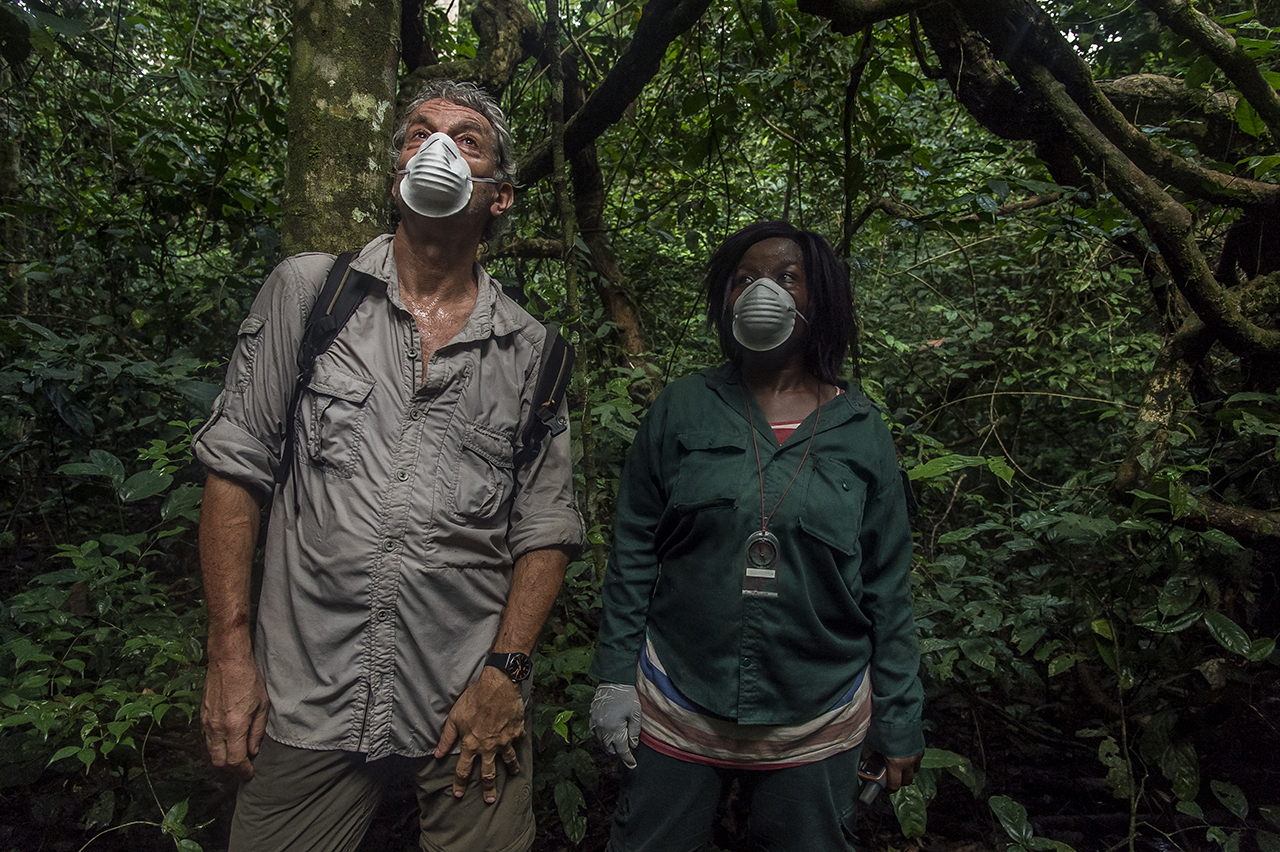
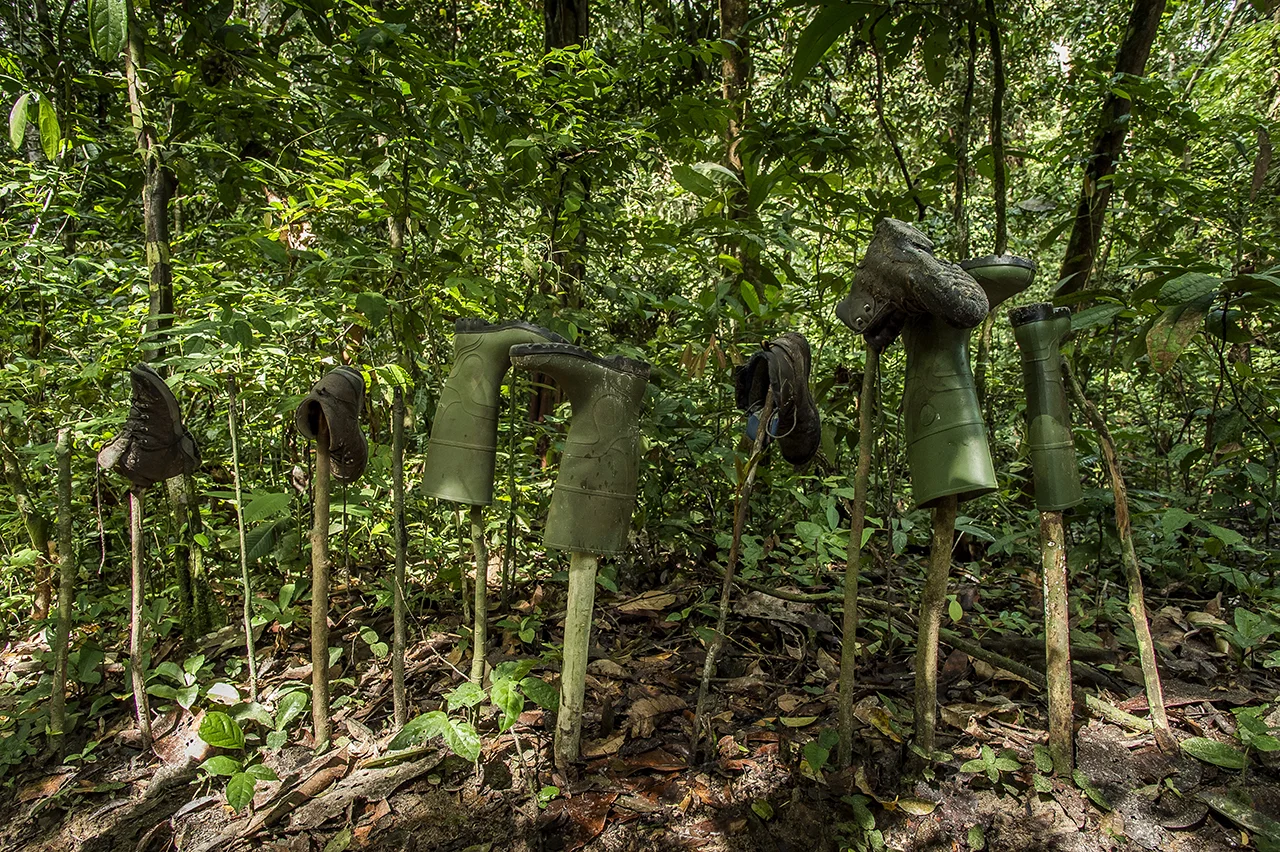

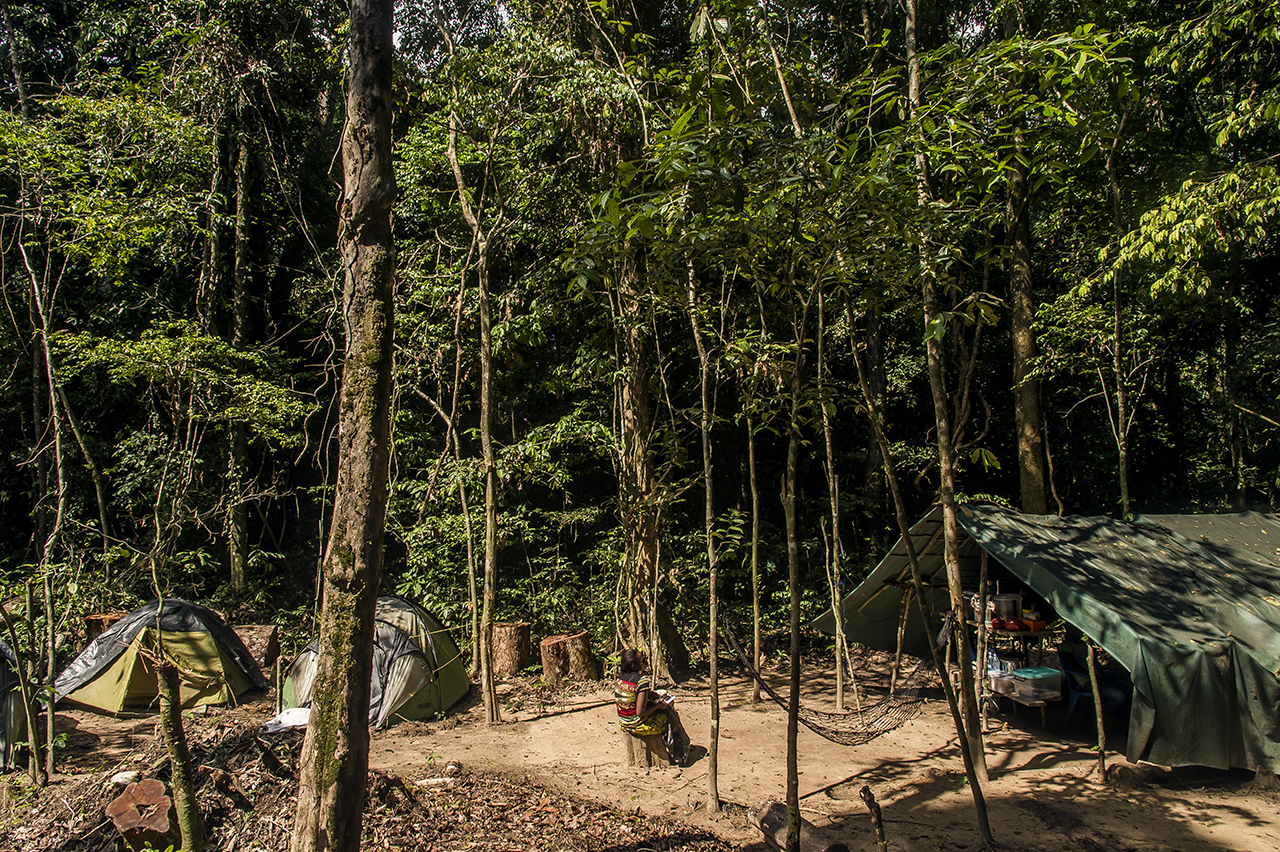
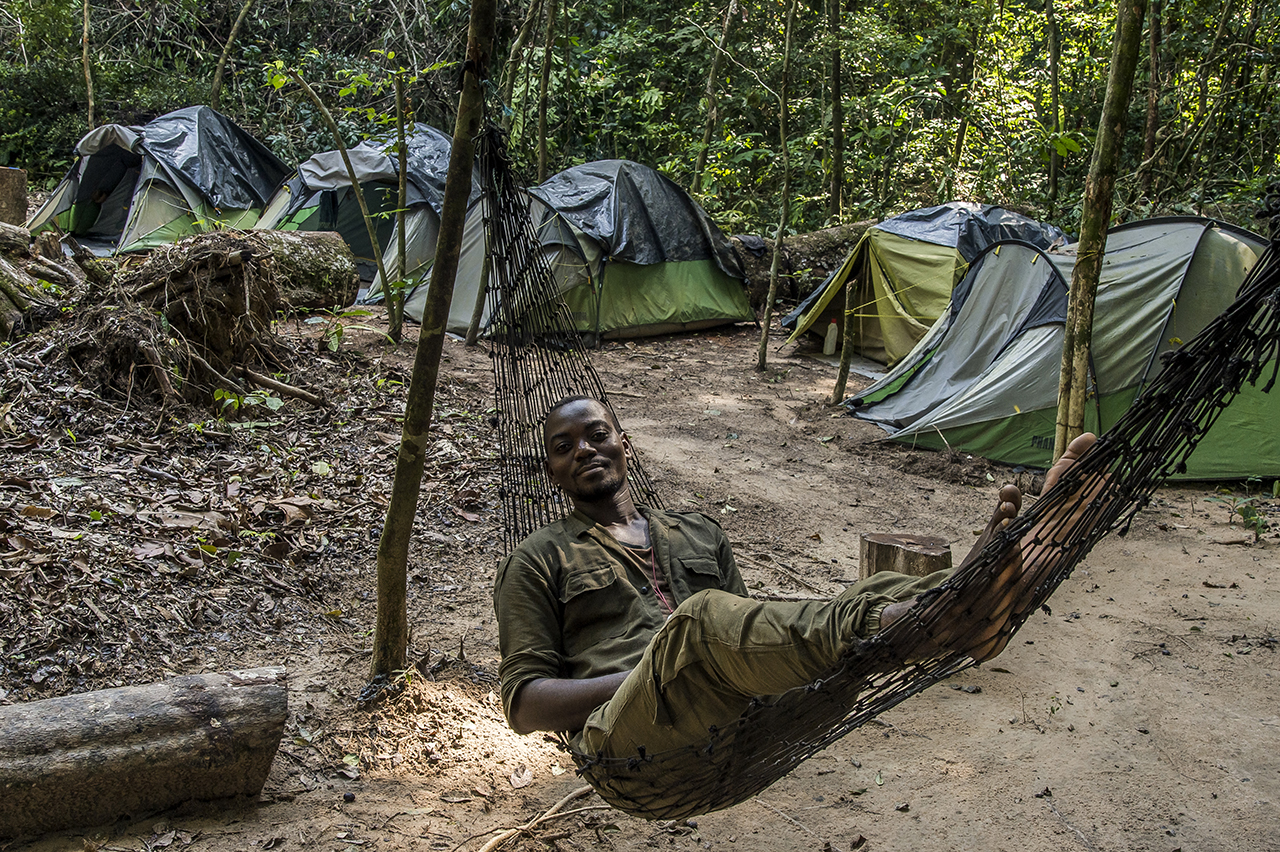

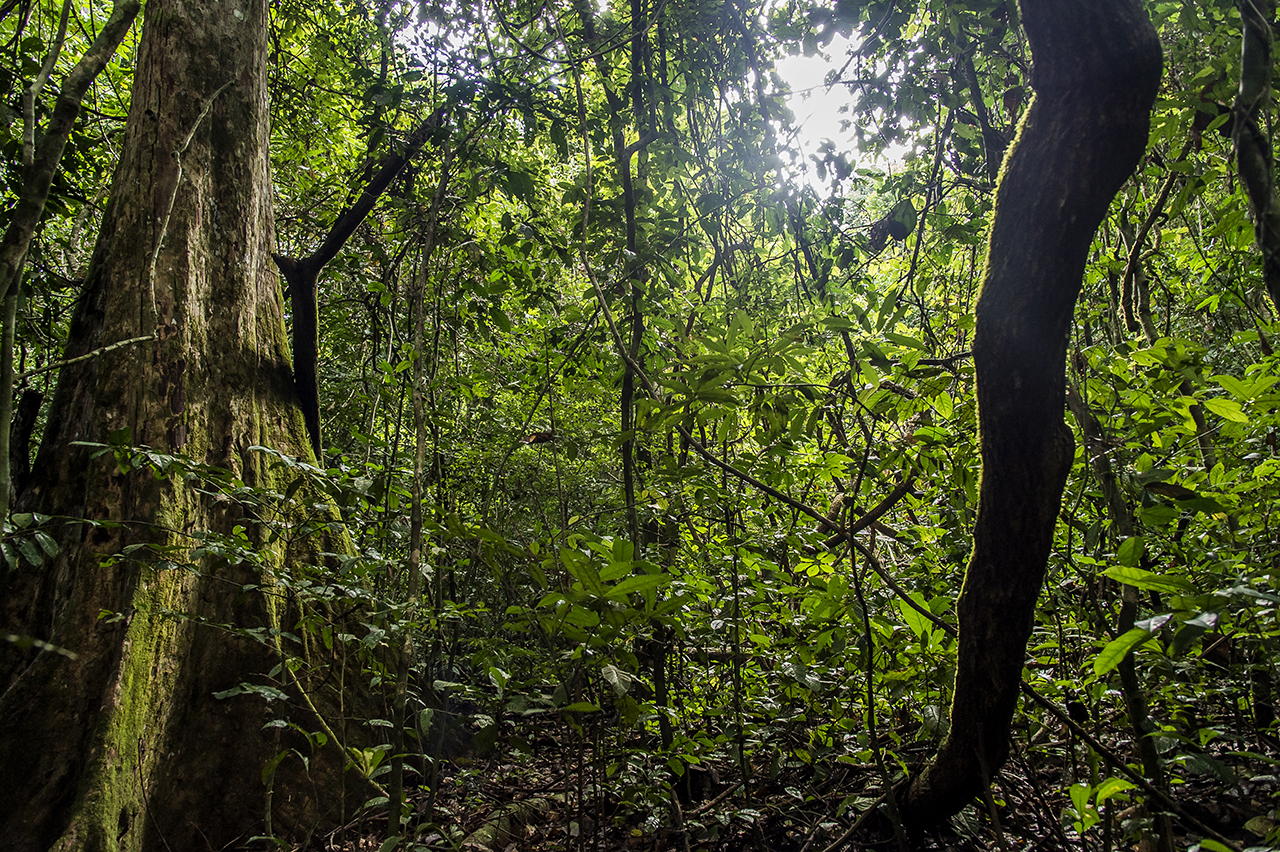
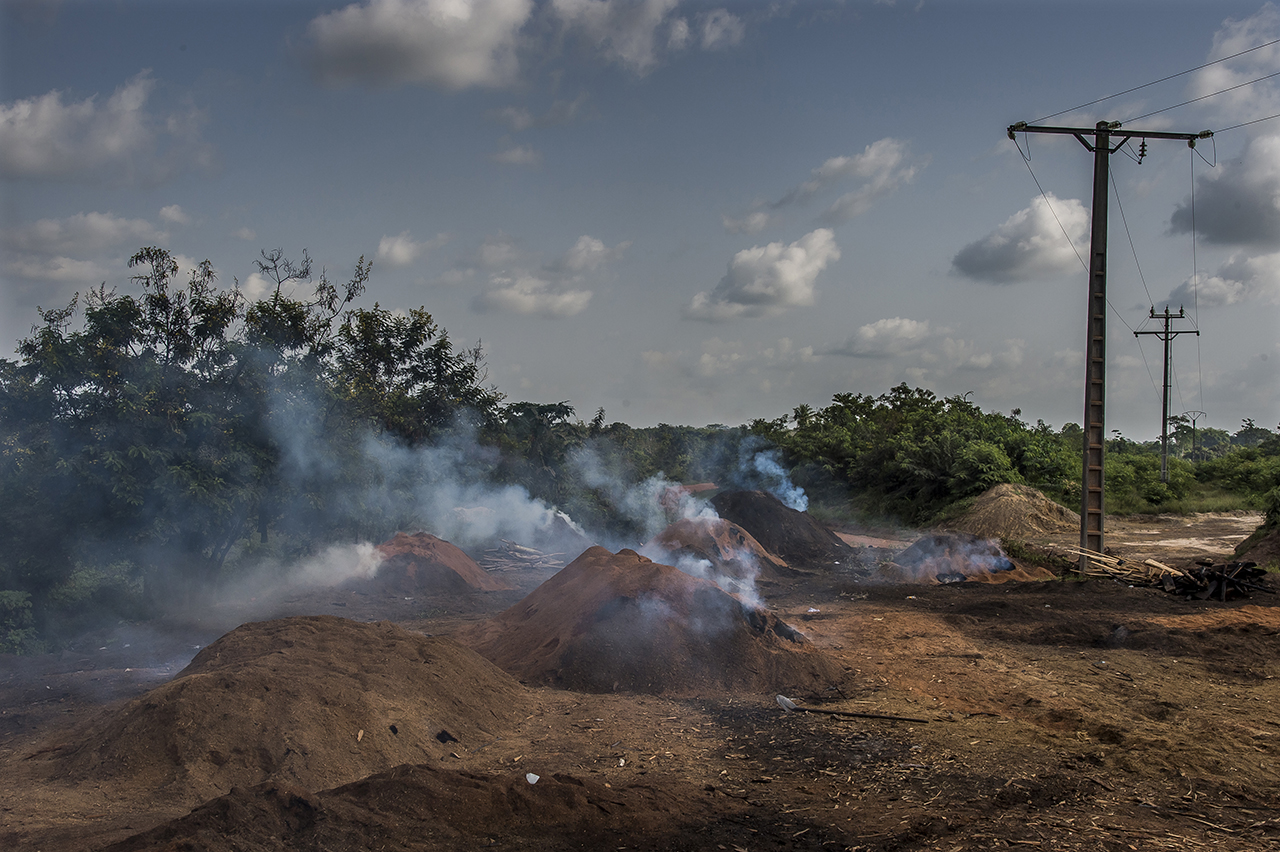
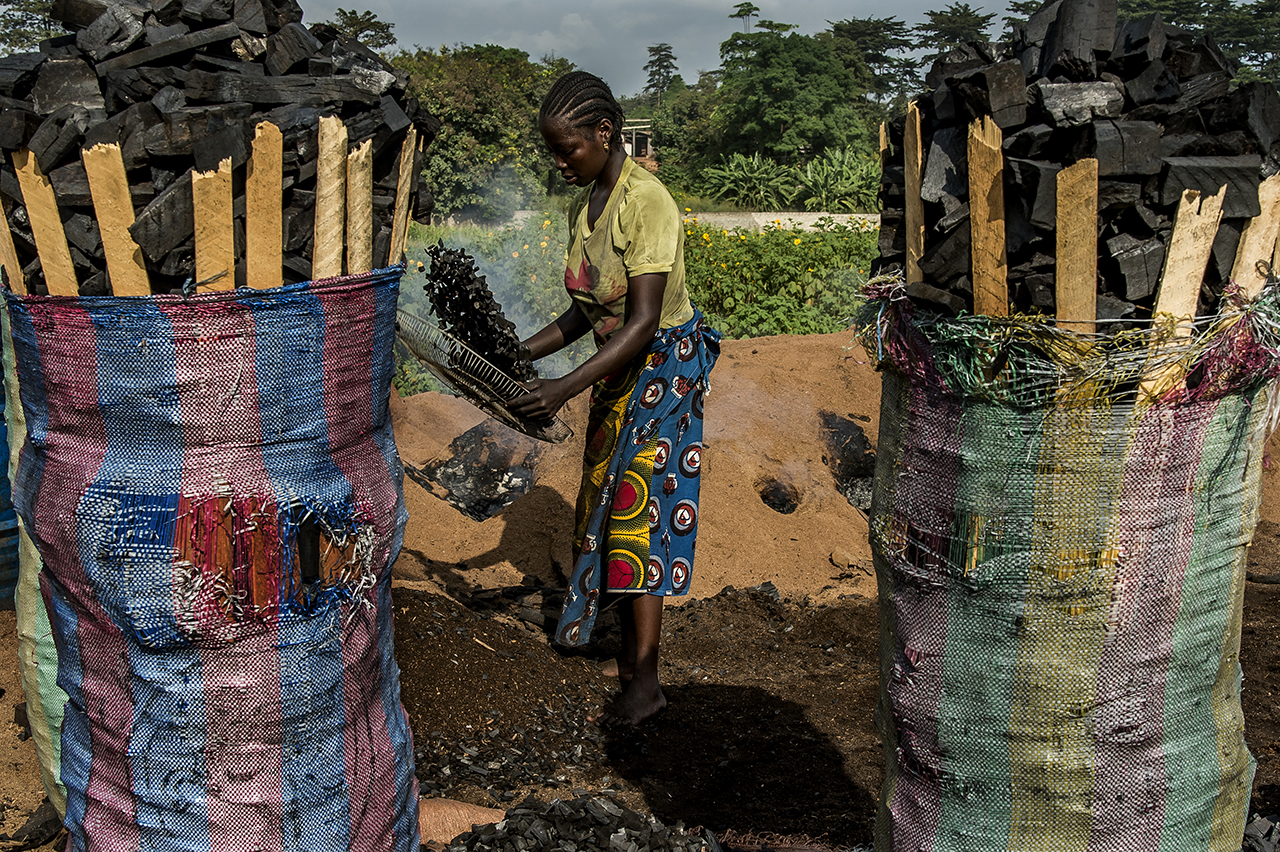
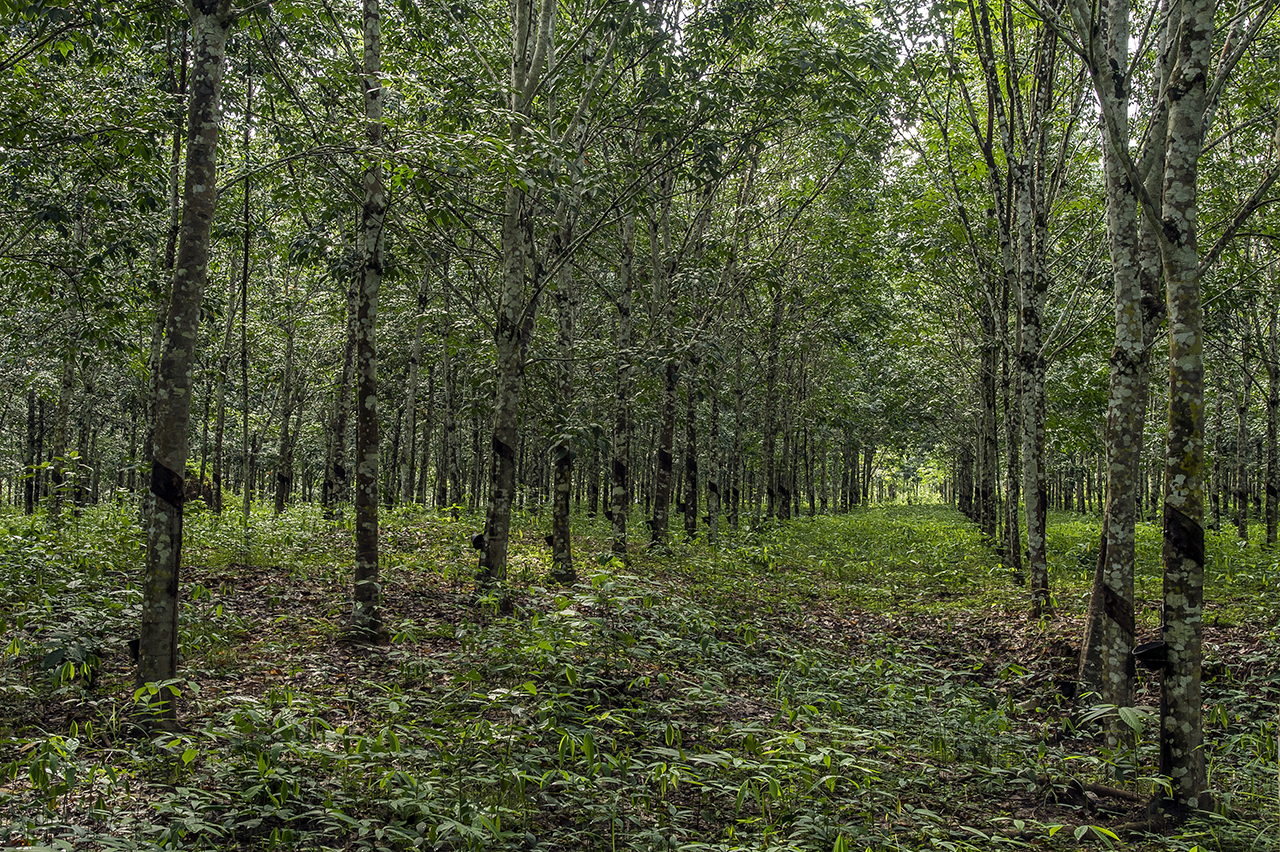
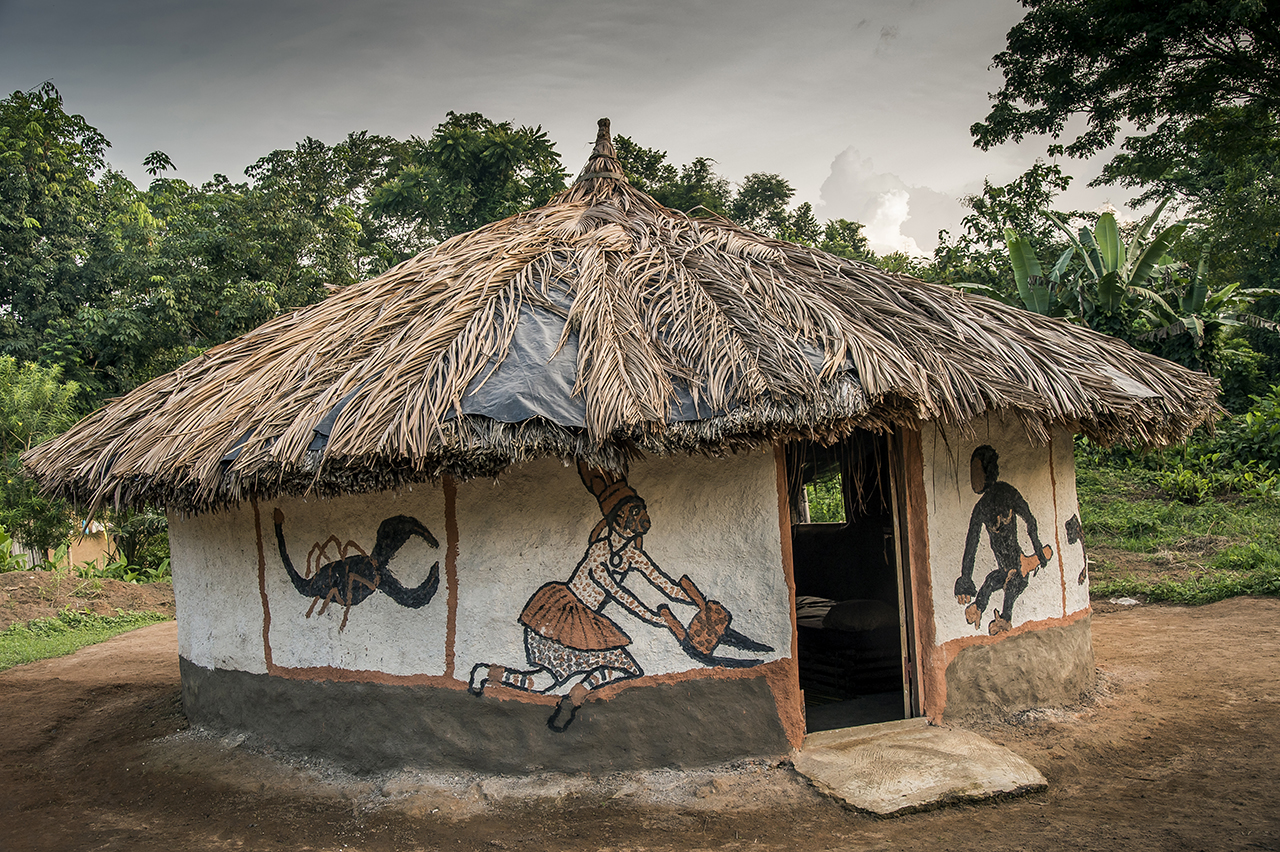

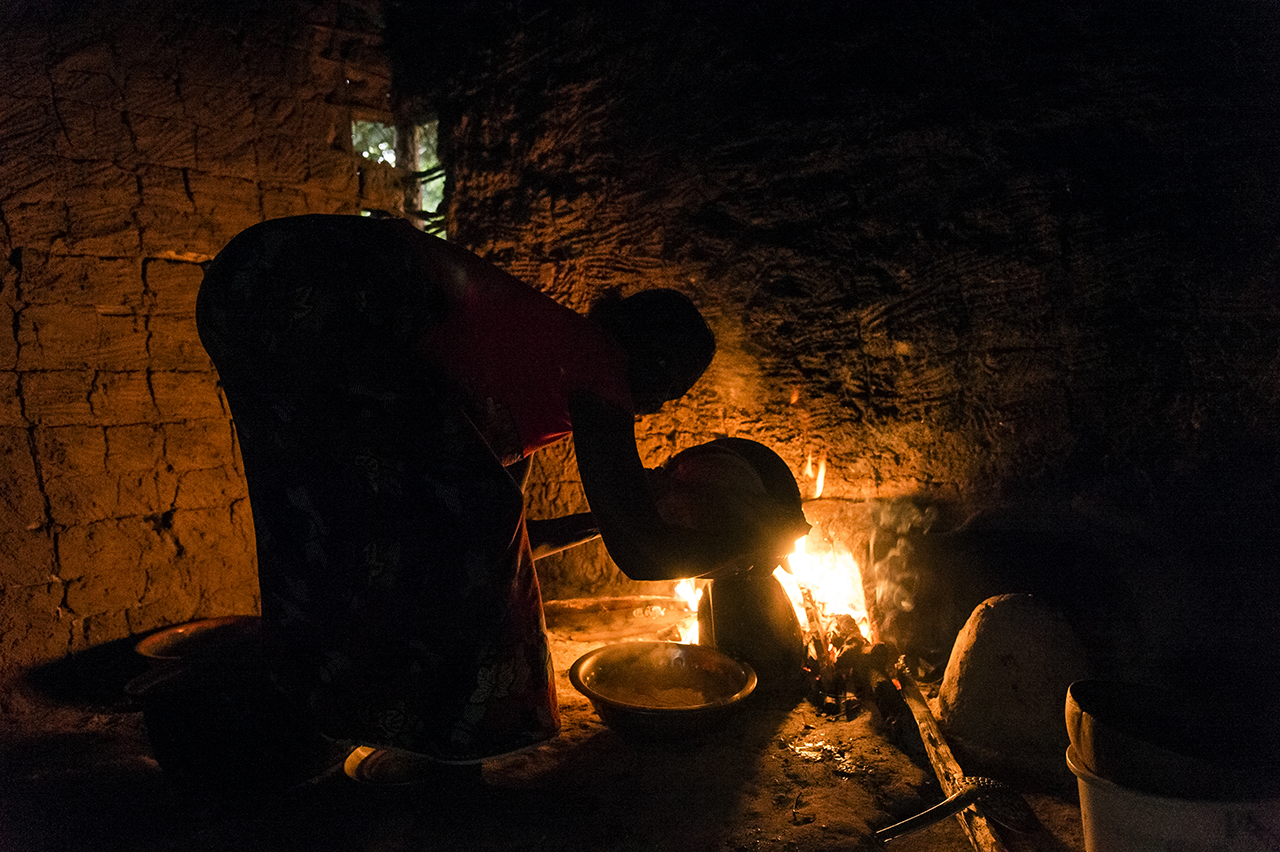
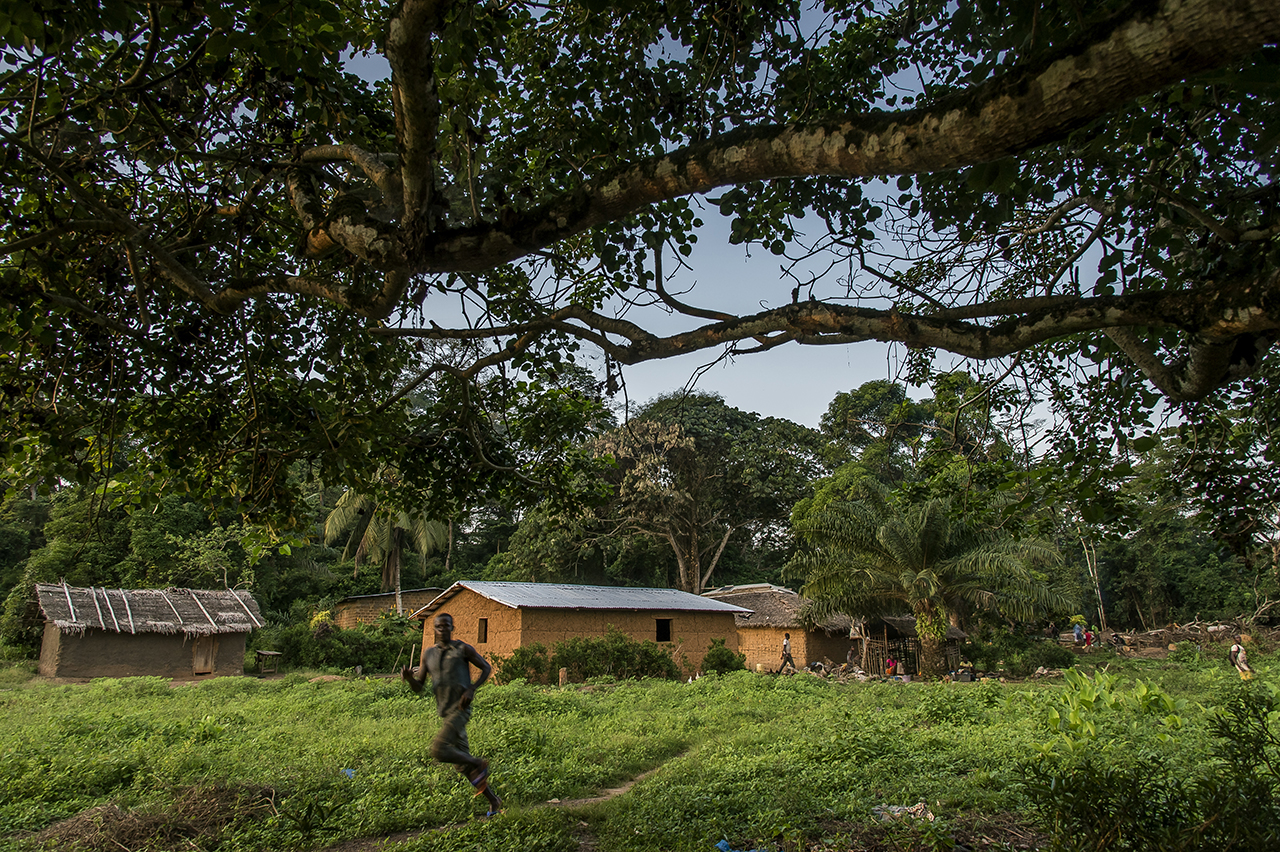
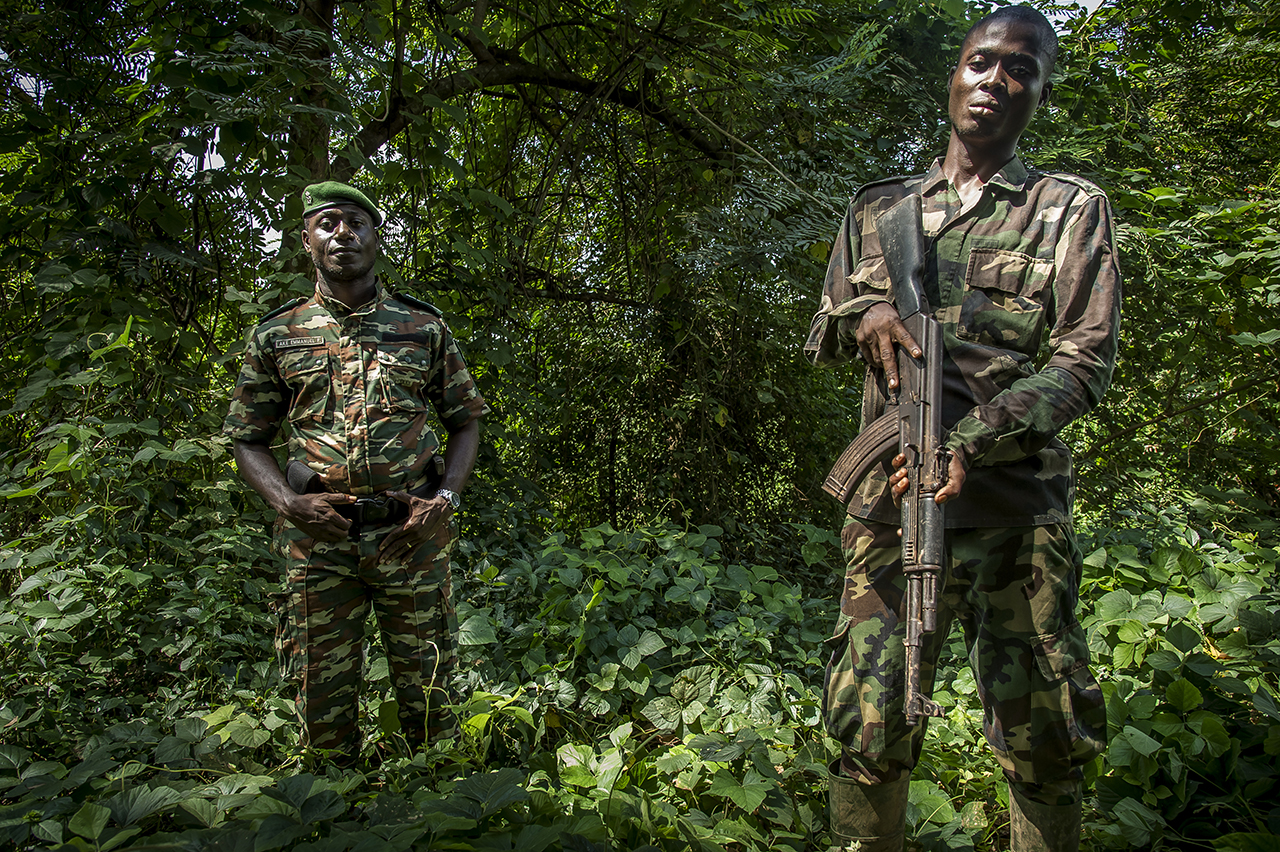
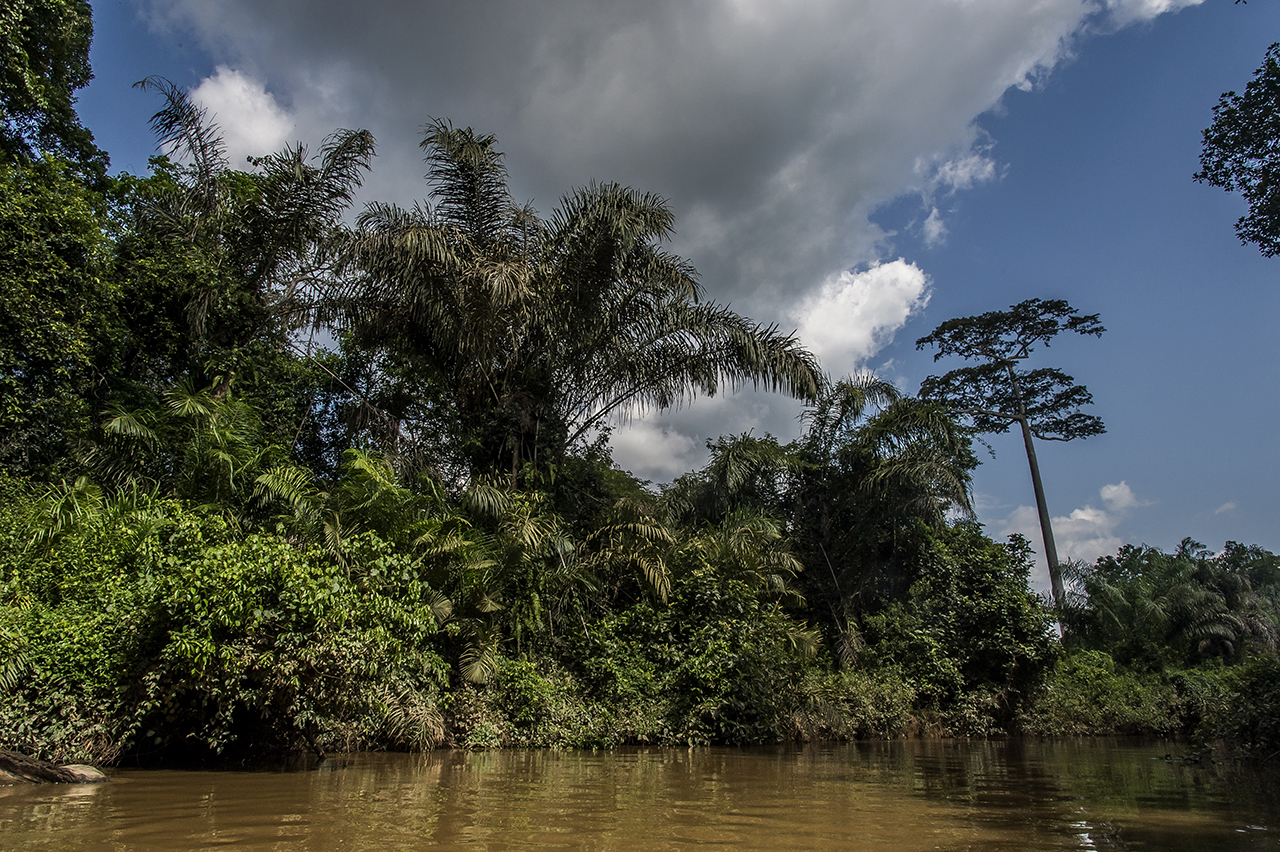
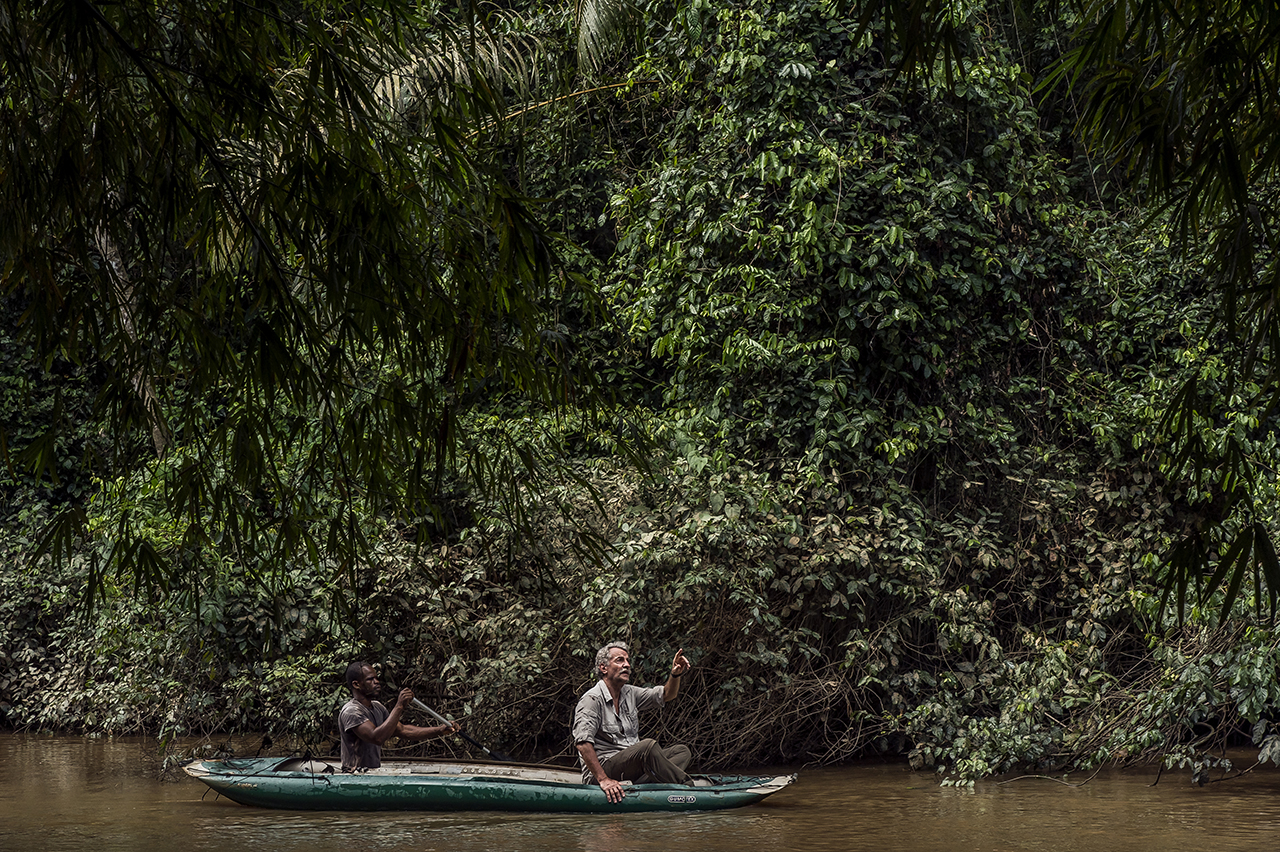
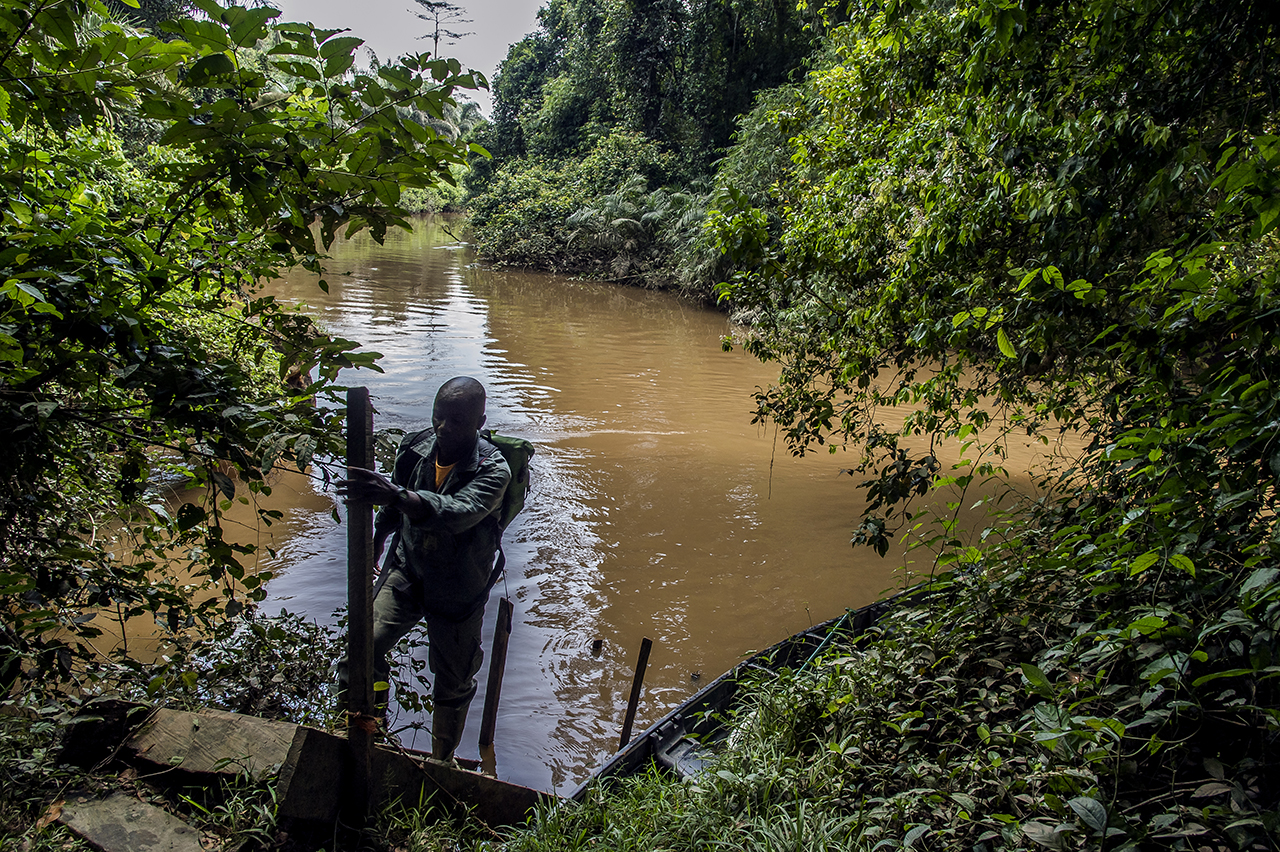

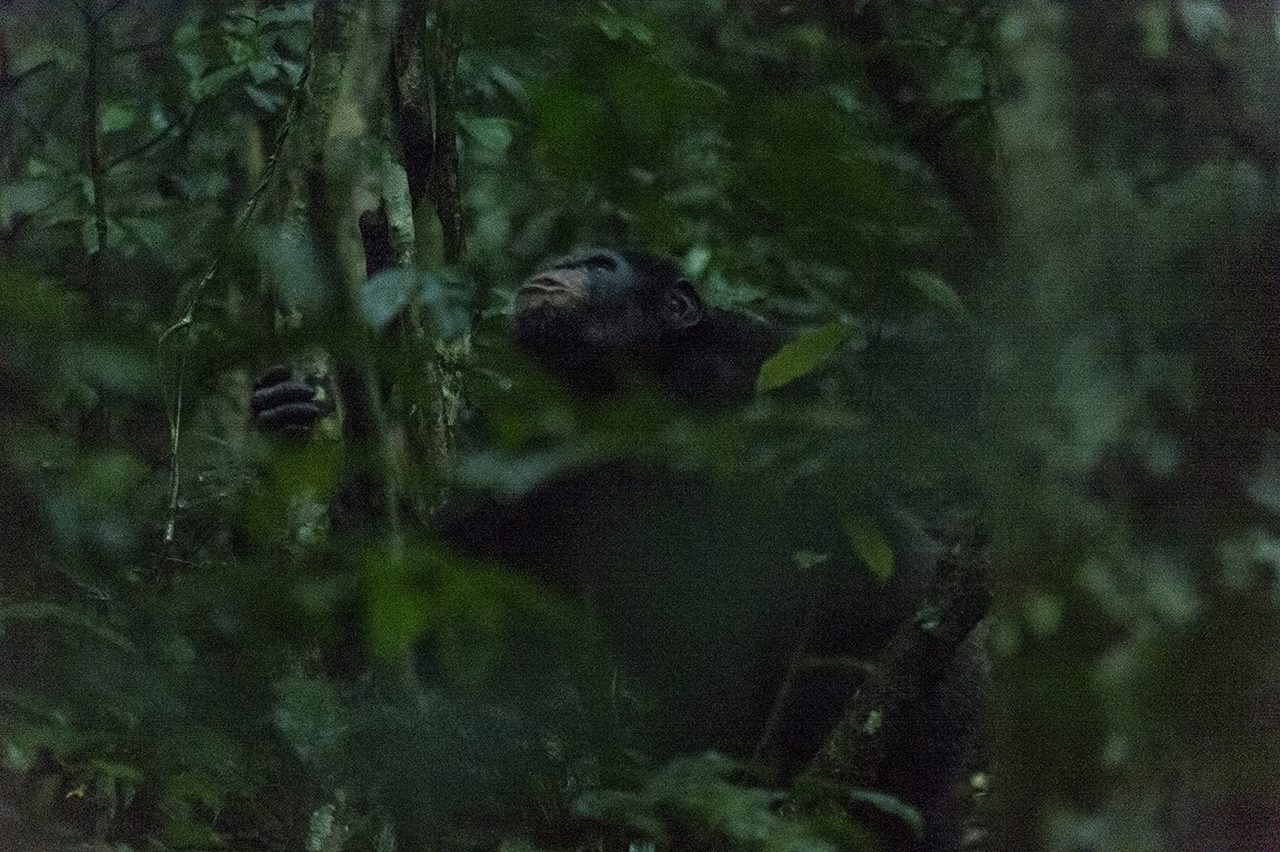
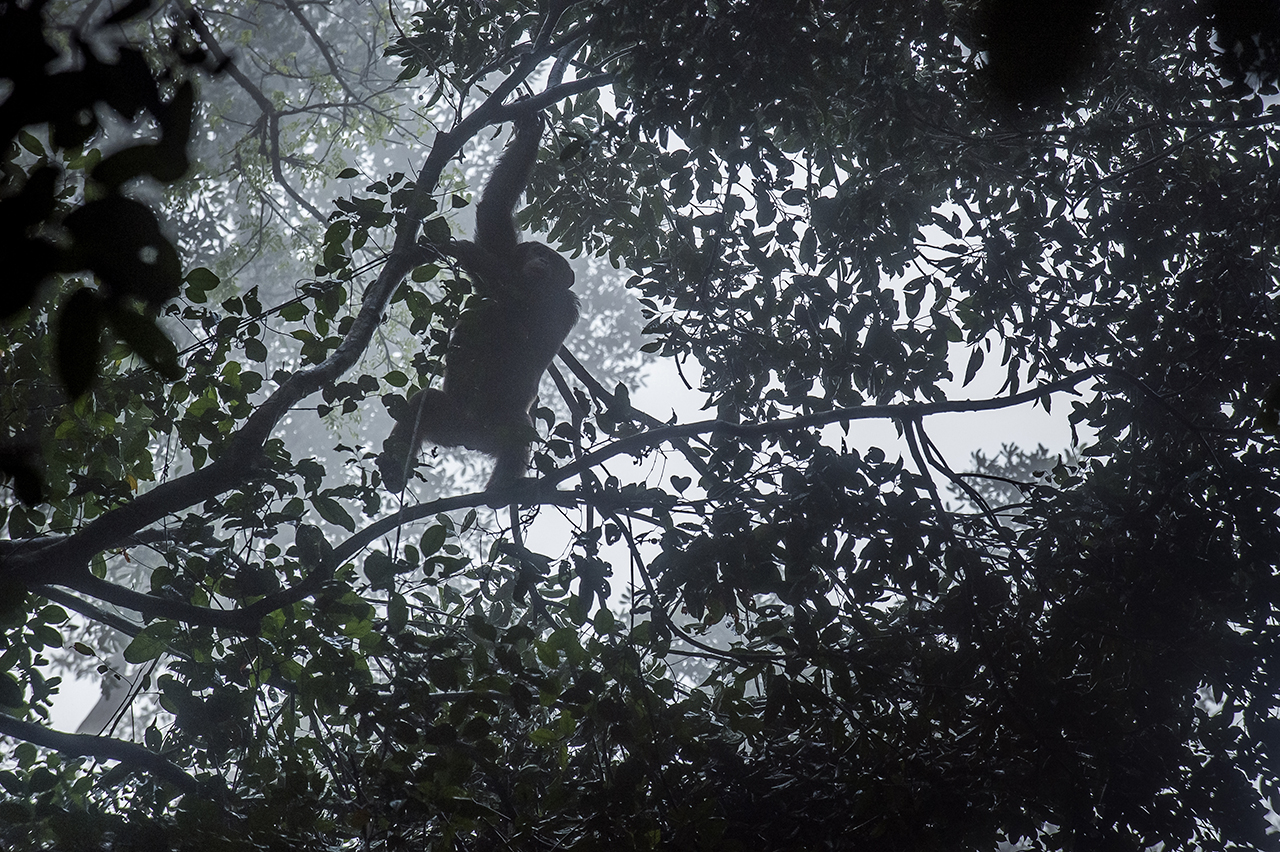
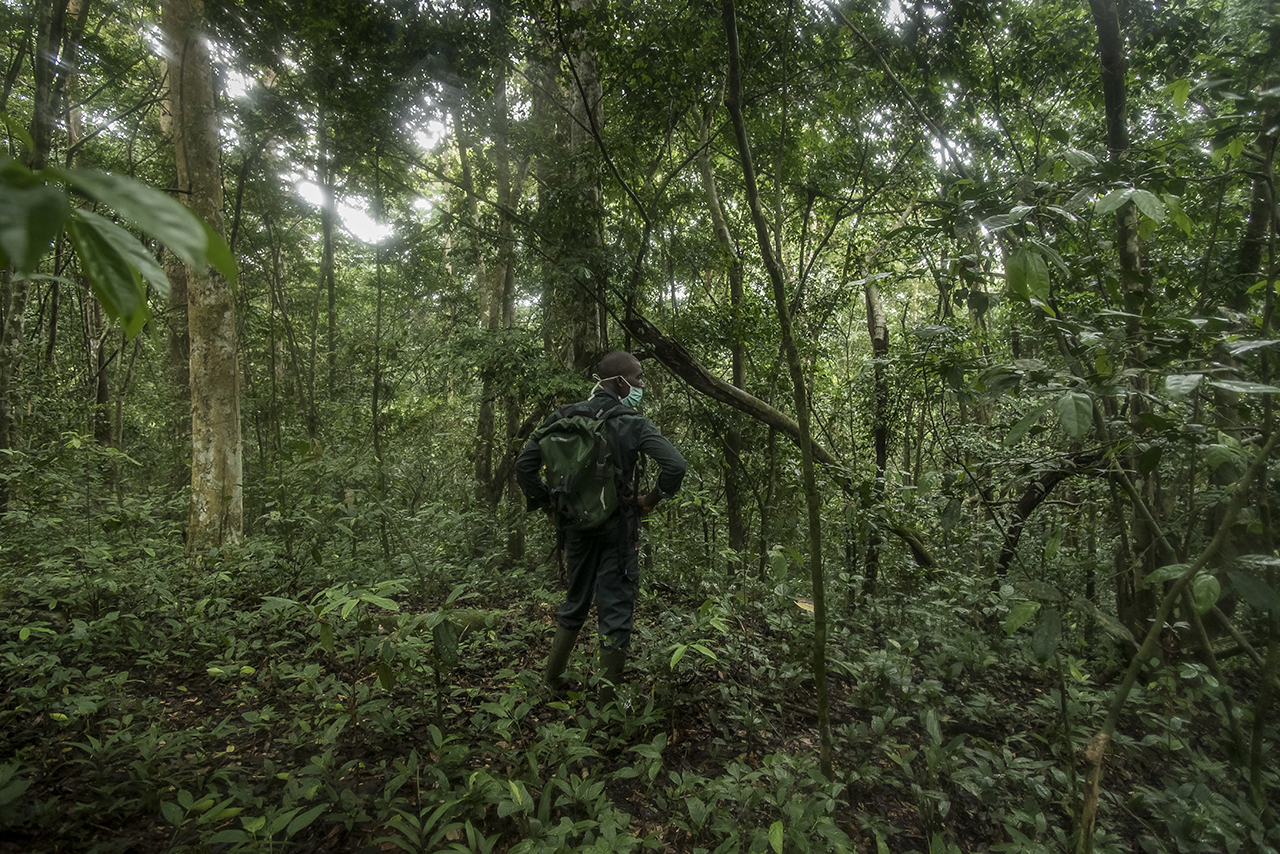
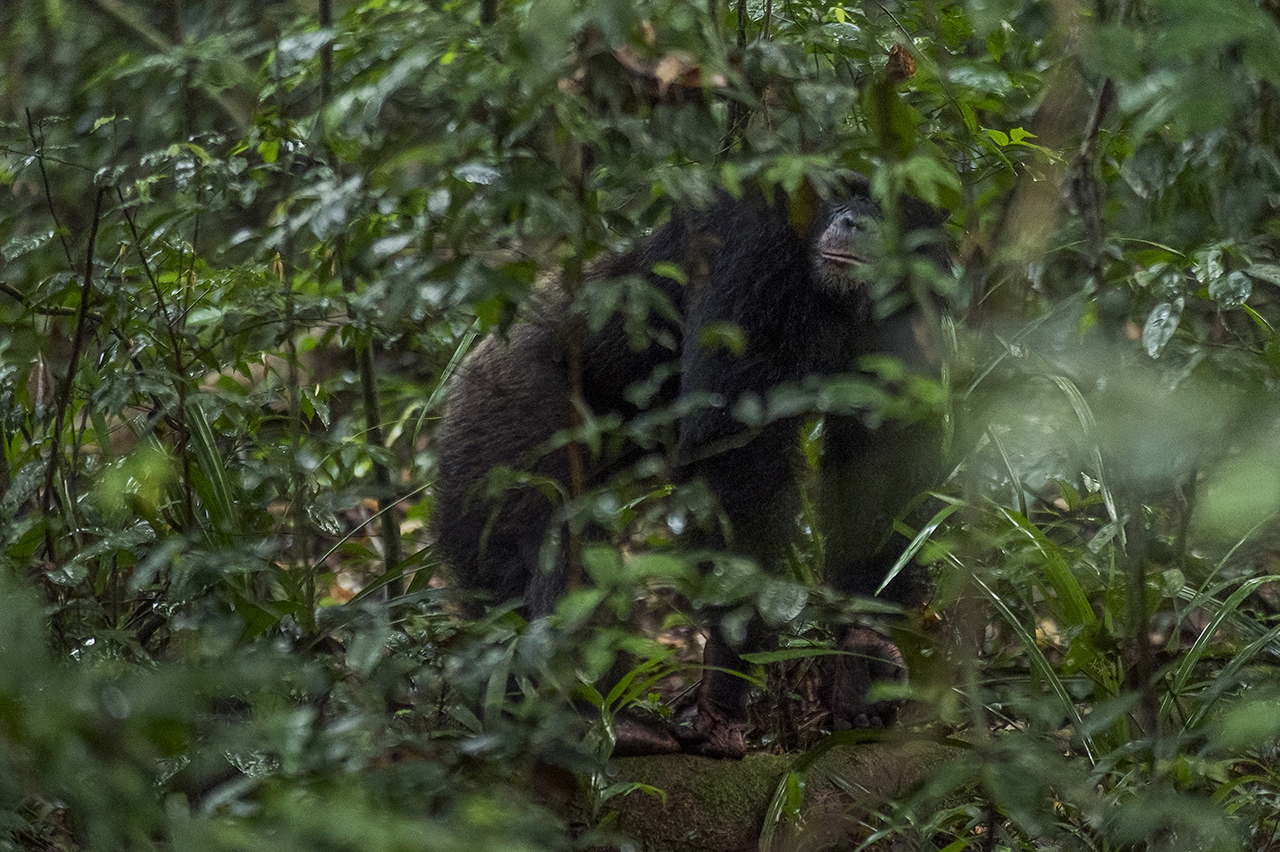
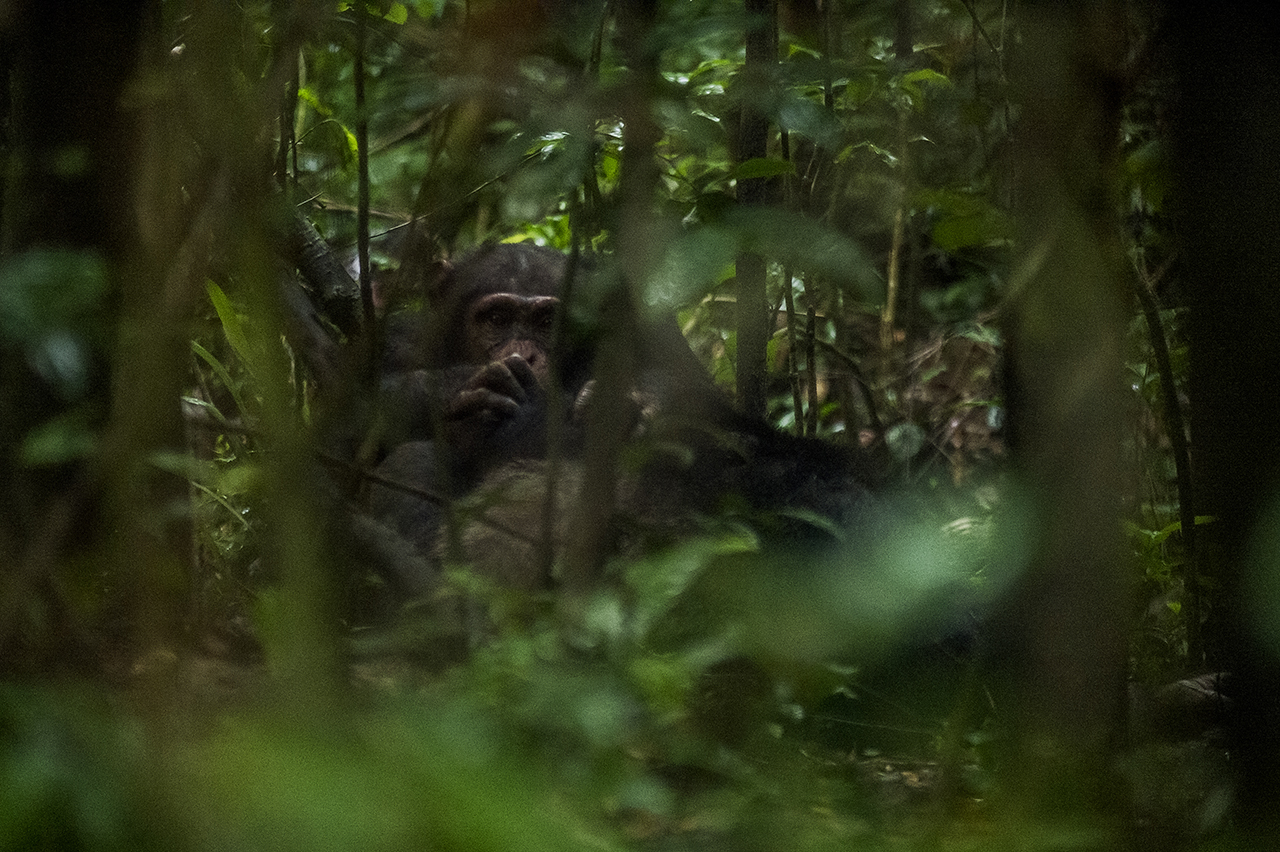

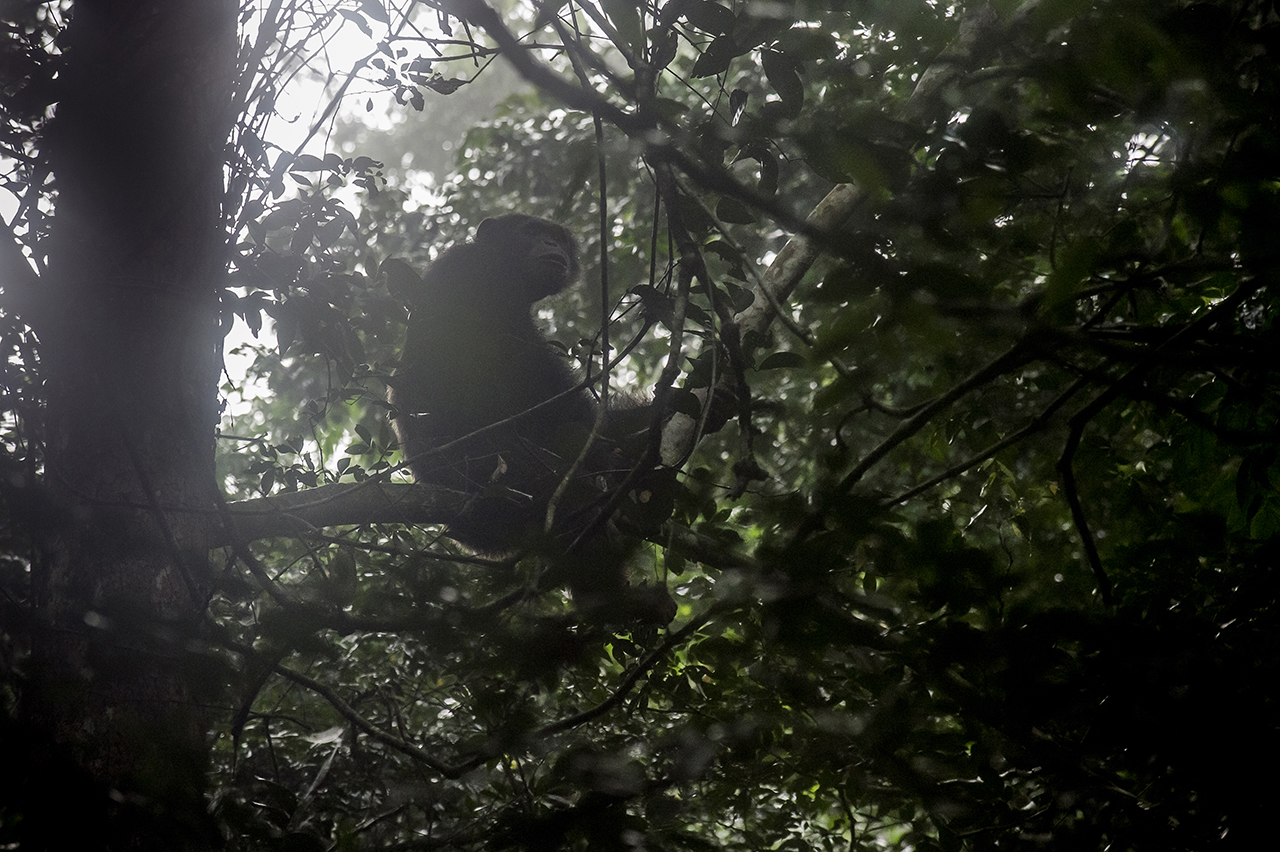
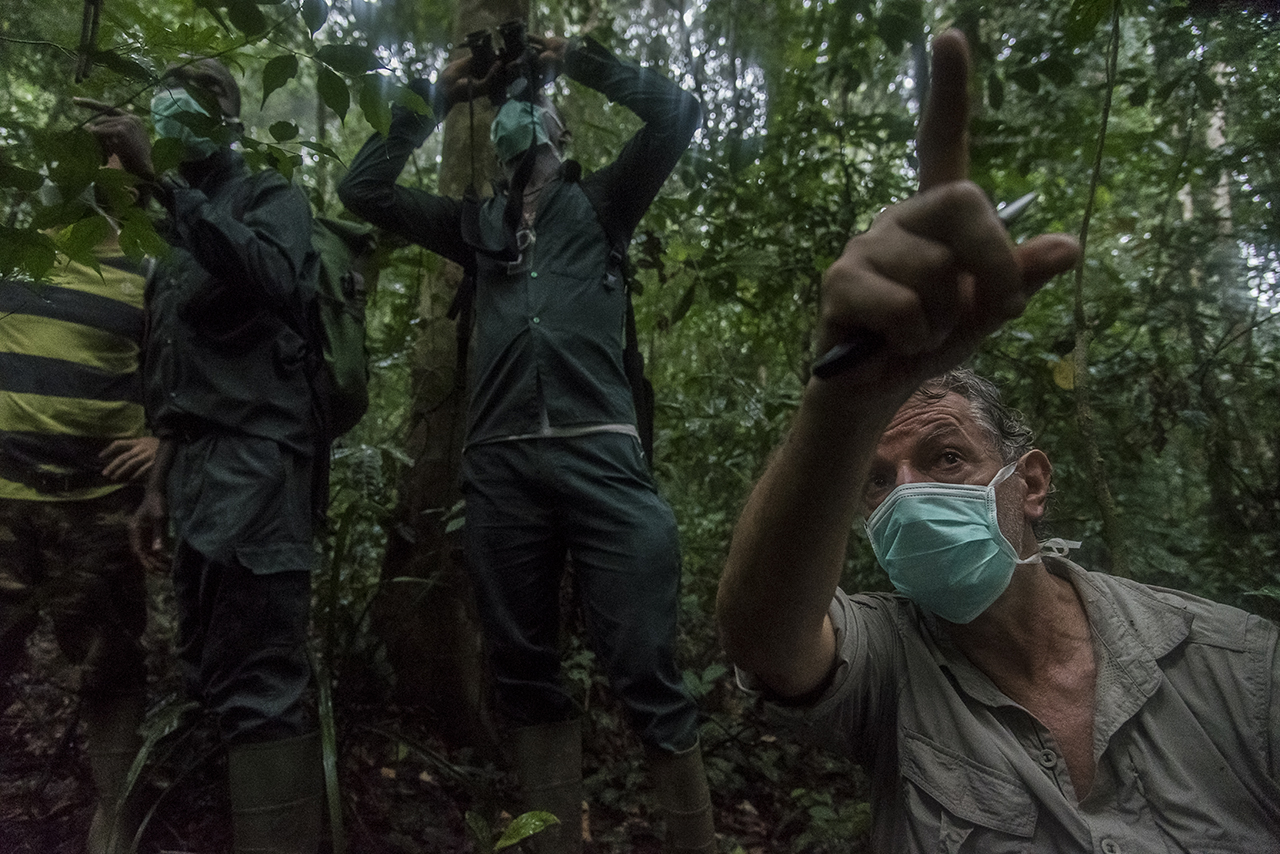
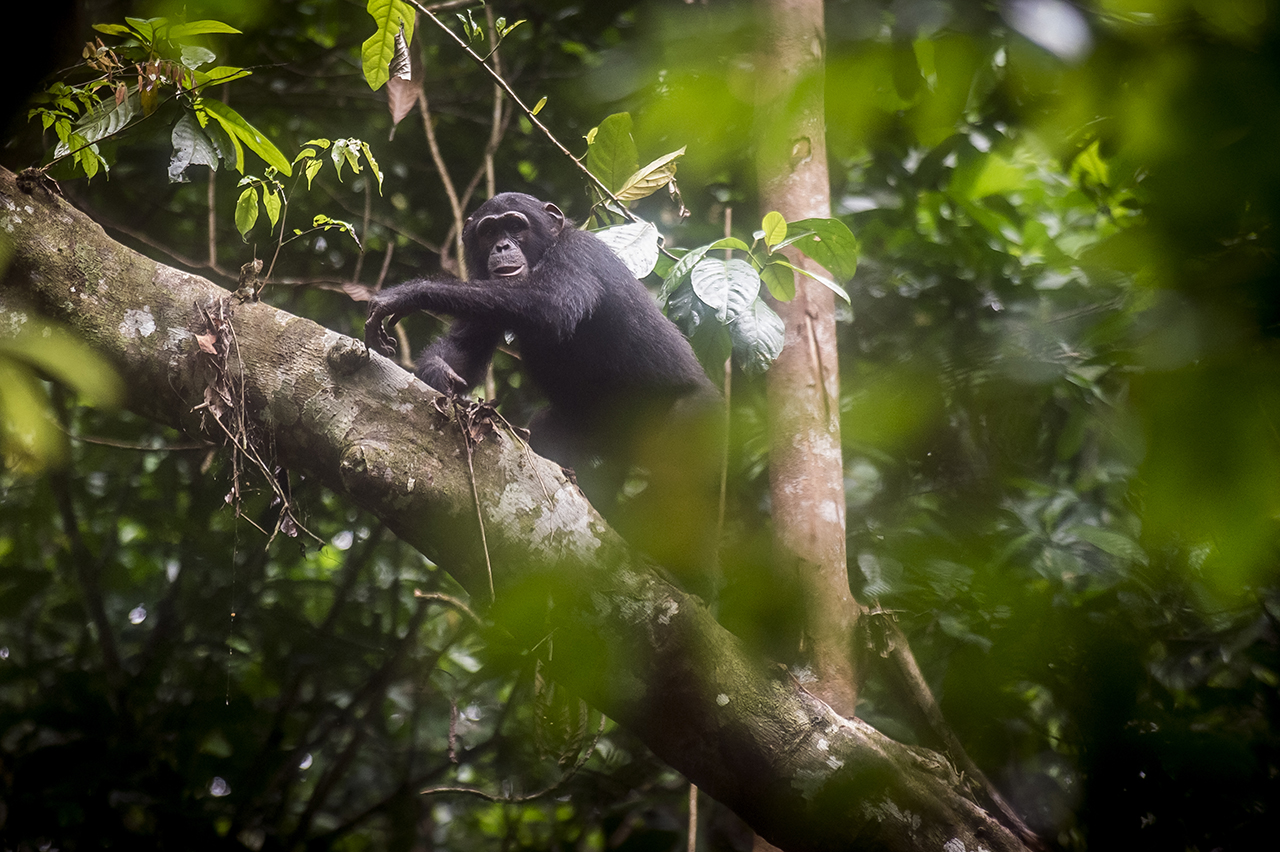


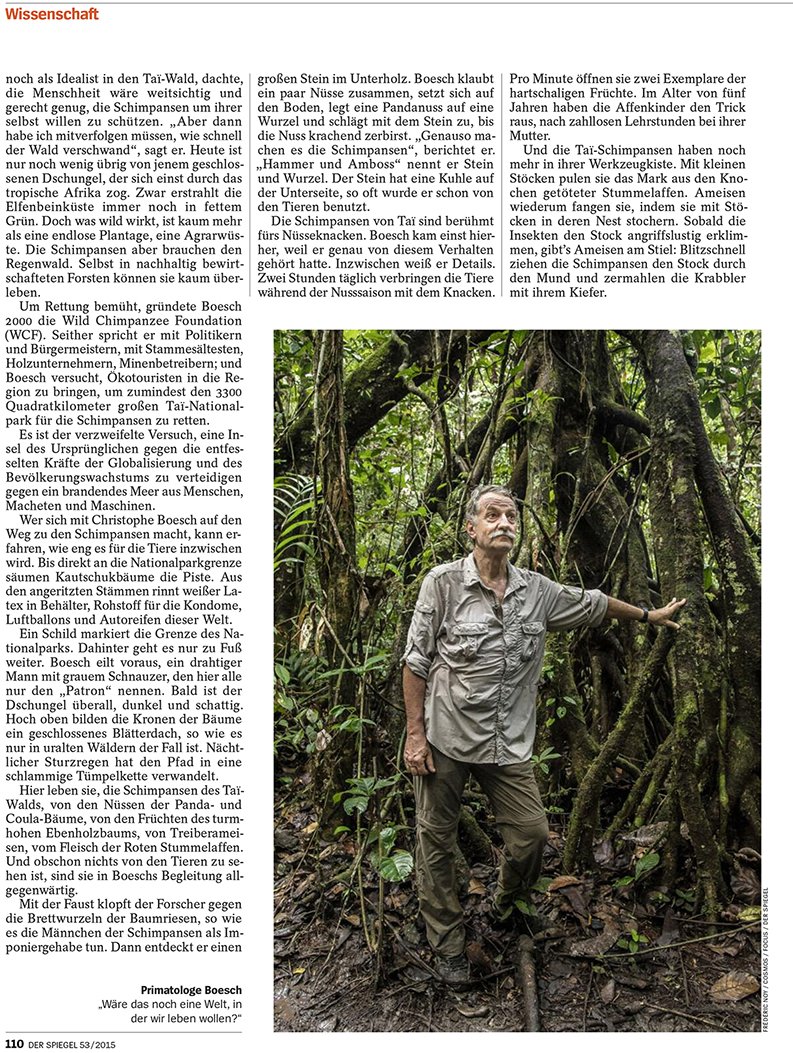

On the road to "Camp Boye", an eco-tourism camp of the Wild Chimpanzee Foundation (WCF), located in the heart of the rainforest in the Taï National Park, named after the city of Taï which lies between its western boundary and the Cavally River, being border between Côte d'Ivoire and Liberia. This national park is located in the west of the country, near Guinea and Liberia. It covers 4,540 km21 around Mount Niénokoué and contains one of the last primary forests in Africa. It has been a UNESCO World Heritage Site since 1982.
From 1977 to 1987, Côte d'Ivoire lost 42% of its entire forest, the highest deforestation rate ever recorded in any country. As a result, primates in the region are particularly threatened. In addition, relict forests have degraded, been fragmented and become poaching grounds. The monkeys, including chimpanzees, are particularly victims, while they are necessary for the regeneration of the forest.

Christophe Boesch, a Franco-Swiss primatologist, takes a break in the forest of Taï on the way to "Camp Boyé" one of the 2 eco-camp of the National Park of Taï, in Ivory Coast. Since 1997, he is the director of the Department of Primatology at the Max Planck Institute of Evolutionary Anthropology, located in Leipzig, Germany.
Since 1976, Christophe Boesch has been conducting research in the Taï National Park to better understand the behavior and life of chimpanzees in order to put it into perspective with human evolution, especially with regard to the emergence of cognitive and cultural skills.
Boesch is best known for his studies on the use of tools in chimpanzees through which he analyzes their social behavior and the processes of social and cultural reproduction; it also analyzes the hunting and territorial behavior of chimpanzees.
In 2000, Christophe Boesch founded the Wild Chimpanzee Foundation (WCF), which aims to protect wild chimpanzees.

Two eco-guides of the Wild Chimpanzee Foundation (WCF) in the Tai tropical forest, in Tai National Park. They are responsible for the observation, location and census of chimpanzees.

A group composed by an eco-guide, Thierry Fabien, coordinator for all activities of the Wild Chimpanzee Foundation (WCF) in Taï and porters walking in the forest of Taï, en route to "Camp Boyé", a camp located in the heart of the rainforest.

Christophe Boesch, primatologist, crosses a small river in the forest of Taï on the way of "Camp Boyé" one of the 2 eco-camp of the National Park of Taï, in Ivory Coast. It rained recently. The trails are muddy and regularly cut by small springs and ponds.

Christophe Boesch, a Franco-Swiss primatologist, presented a demonstration of walnut breaking to eco-guides of the Wild Chimpanzee Foundation, which he founded in 2000. Since 1976, he has been conducting research in the Taï National Park.
Taï chimpanzees are famous for the nuts they crack using tools. Christophe Boesch first came to Tai because he had heard about this behavior. Now he knows the details. Animals spend two hours a day in spring season cracking shells, using tools: stones or sticks that they use as hammers. They then seek a solid support such as a tree root, which they use as an anvil. They lay the nut on it and open it by hitting it with their "hammer".
Each minute they open two of these hard-shell fruits. At the age of five, chimpanzees do their job, thanks to the countless hours of instruction given by their mother.
Taï chimpanzees are known worldwide for using the most tools, 26 in total. To extract almond debris, fish ants or honey, they shape sticks of different sizes and lengths. They break placed on a solid support, with stones or pieces of branch nuts. They make sponges of leaves to drink water.

An eco-guide of the Wild Chimpanzee Foundation (WCF), takes notes on the monkeys that she sees above her head in the canopy, in the tropical forest of Tai, in the National Park. Like any person entering primate territory, she wears a surgical mask so as not to transmit human diseases to the animals.

The heat is intense and the humidity suffocating in the rainy forest of Tai. Christophe Boesch, a Franco-Swiss primatologist who has been doing research on chimpanzees since 1976 and an eco-guide of the Wild Chimpanzee Foundation (WCF), observe the monkeys that pass over them in the canopy, in the National Park of Tai. Like any person penetrating the territory of the primates, they wear surgical masks so as not to transmit human diseases to the animals.

At the entrance of "Camp Boyé", an eco-camp of the Wild Chimpanzee Foundation (WCF) in the middle of the tropical forest of Taï, the eco-guides let their boots dry, head down to prevent any insect or snake to nest inside. To avoid contamination from the forest to the camp and vice versa, pediluvium are installed at each entrance to the camp. Any guest is required to soak his boots in, put them to dry at the entrance and move around the camp with other shoes. When he leaves for the forest, he will execute the opposite operation.

At the entrance of "Camp Boyé", an eco-camp of the Wild Chimpanzee Foundation (WCF) in the middle of the tropical forest of Taï, eco-guides tries to dry their clothes. The humidity is extremely high in the forest. Everything dries really slowly, if only it dries.

In the middle of the clearing pruned in the heart of the tropical forest to build "Camp Boyé", the cook takes a break and lazes in the sun. There are two small eco-camps in the region, one managed by the Wild Chimpanzee Foundation (WCF) "Camp Boyé" and the other by the Ivorian Office of Parks and Reserves, which is the national Ivorian authority . Approximately 150 visitors are staying in one or the other during a year.

In the clearing in the middle of the tropical forest where "Camp Boyé" is located, an eco-camp run by the Wild Chimpanzee Foundation (WCF), an eco guide lyes in a hammock in front of the tents row where its colleagues and he spend the nights. Behind the tents, already begins the rainforest.

The "Camp Boyé" luxury tent, an eco-camp managed by the Wild Chimpanzee Foundation (WCF) in the middle of the Taï rainforest, is a two and a half hour walk from the edge of the forest. There are two small eco-camps in the region, one managed by the Wild Chimpanzee Foundation (WCF) "Camp Boyé" and the other by the Ivorian Office of Parks and Reserves, which is the national Ivorian authority . Approximately 150 visitors are staying in one or the other during a year.

Around "Camp Boyé", an ecotourism campground managed by the Wild Chimpanzee Foundation (WCF), located in the heart of the rainforest in the Taï National Park, named after the town of Taï, which lies between its western boundary and the river Cavally, the border between Côte d'Ivoire and Liberia. This national park is located in the west of the country, near Guinea and Liberia. It covers 4,540 km21 around Mount Niénokoué and contains one of the last primary forests in Africa. It has been a UNESCO World Heritage Site since 1982.
From 1977 to 1987, Côte d'Ivoire lost 42% of its entire forest, the highest deforestation rate ever recorded in any country. As a result, primates in the region are particularly threatened. In addition, relict forests have degraded, been fragmented and become poaching grounds. The monkeys, including chimpanzees, are particularly victims, while they are necessary for the regeneration of the forest.

On the outskirts of the village of Guiglo, charcoal kilns, fueled by wood waste from the forestry industry smoke. The charcoal thus obtained will be sold on the markets of Abidjan at 10 hours of roads from there.
One of the biggest threats to chimpanzees today is the loss of their living space: the African rainforest. Many hectares of forest are destroyed by fire to obtain fields allowing farmers to grow cereals and other fruits of the fields. When the soil is exhausted and the cereals no longer grow, they continue their advance on the forest. But if the forest has been destroyed, chimpanzees have no more space to live. They have to choose between migrating in turn, or dying.
In 2008, the Ivorian Society for the Development of Forest Plantations (Sodefor) estimated that 300,000 hectares of forests are disappearing each year as a result of the "misuse" of wood, linked to coal production or tree cutting for the export of precious woods.

On the outskirts of the village of Guiglo, a young woman sifted pieces of charcoal before sacking them. The charcoal thus obtained will be sold on the markets of Abidjan at 10 hours of roads from there.
One of the biggest threats to chimpanzees today is the loss of their living space: the African rainforest. Many hectares of forest are destroyed by fire to obtain fields allowing farmers to grow cereals and other fruits of the fields. When the soil is exhausted and the cereals no longer grow, they continue their advance on the forest. But if the forest has been destroyed, chimpanzees have no more space to live. They have to choose between migrating in turn, or dying.
In 2008, the Ivorian Society for the Development of Forest Plantations (Sodefor) estimated that 300,000 hectares of forests disappear every year as a result of the "misuse" of wood, linked to coal production or tree cutting for the export of valuable species.

Near the Taï National Park, mud tracks are bordered by lines of rubber tree. Latex, a raw material for condoms, balloons and tires around the world, sinks into small containers.
More than three-quarters of Côte d'Ivoire's forests have disappeared in half a century due to extensive agriculture and urbanization. The Ivorian forest has experienced a "continuous deterioration", going from 16.5 million hectares to independence in 1960 to 2 million in 2014, ie "less than 13% of the national territory against 78%. Dense forests cover only 4% of Côte d’Ivoire.

A guesthouse for tourists in the village of Gouleako, near the National Park of Taï. To limit poaching and agricultural encroachment on the forest, it is essential that the local populations are integrated into the economic scheme of eco-tourism.

Village of Gouleako, on the road to the forest of Taï and its national park. An elder, actual village leader, Victor Tere of the Oubi tribe (left in blue) and a friend. "Formerly we were hunters and went into the forest. The whites took the forest. Now they have to give us back something. "

In a house in the village of Gouleako, close to the Taï National Park, a 10-minute drive from the town of Taï, a woman prepares the evening meal. Gouleako is part of an eco-tourism circuit. Visitors can spend the night there eating and hearing the history of the village during a traditional evening organized and managed by the villagers. To limit poaching and agricultural encroachment on the forest, it is essential that the local populations are integrated into the economic scheme of eco-tourism.

Village of Gouleako, close to the Taï National Park, a 10-minute drive from the town of Taï. Gouleako is part of an eco-tourism circuit. Visitors can spend the night there eating and hearing the history of the village during a traditional evening organized and managed by the villagers. To limit poaching and agricultural encroachment on the forest, it is essential that the local populations are integrated into the economic scheme of eco-tourism.

Emmanuel Francelin Ake (left), Head of Sector of the Ivorian Office of Parks and Reserves (OIPR) in the town of Djouroutou, on the western edge of the Taï National Park, responsible for protecting the park and hunting poachers.
The animals that are killed in the bush for food are called "bushmeat". All animals living in the forest, rats, chimpanzees, gorillas and elephants, including snakes, are hunted for their meat. In most parts of Africa, bushmeat hunting is illegal. Poaching is the greatest danger to the survival of chimpanzees. Indeed, when hunting antelopes or other beasts in the bush, hunters do not hesitate to kill chimpanzees or other monkeys. According to the Bushmeat Crisis Statement 2000, "this illegal trade destroys the population of chimpanzees living free, just when it is assumed that protecting their life in the wild can greatly contribute to establish knowledge on how to control the spread of AIDS and other infectious diseases in humans. » One of the problems is that for the more than 24 million people living in forested areas of Africa, bushmeat is their only source of animal protein. Urban populations in Central and West Africa increase by 2 to 4% each year. Families also practice animal husbandry, but as financial investment and insurance. Also bushmeat provides the rural poor with a lucrative source of income and food.

The Hana River. Beyond, the forest and Taï National Park. The chimpanzee population is estimated at 300-500 individuals.

Christophe Boesch, Franco-Swiss Primatologist, Director of the Department of Primatology of the Max Planck Institute of Evolutionary Anthropology (Leipzig, Germany), who has been conducting research in the Tai National Park since 1976 to better understand behavior and life chimpanzees, crosses the Hana River to enter the park where an estimated 300-500 chimpanzees are living.

A forest guide from the Taï National Park climbs the stairs of the makeshift landing stage which allows to dock after crossing the Hana river, on the edge of the National Park of Tai.

A large tree in the Taï rainy forest with its flat, hollow roots. Chimpanzees use them as drums by tapping their roots with fists when they want sex. The continuous rumble can be heard from afar.

A chimpanzee not completely « used-to-humans » in the forest of Tai. This means that he notices the presence to a human when he is closed and that it incites him to move.
About 200,000 chimpanzees live in the tropical belt between Senegal in West Africa and Tanzania / Uganda in East Africa. In 1900, researchers estimate that it was over 1 million. In Côte d'Ivoire, the number of animals has declined by 90% over the last 20 years. In the Taï National Park, the number is estimated at 300 to 500 specimens.

Early morning, in the forest of Tai, a chimpanzee descends from its nest, in a mist due to extreme humidity. To avoid exposure to predators and sleep safely, chimpanzees spend the night in the trees in nests they make daily. A cross of branches and few leaves do the job.
The chimpanzee is closer to man than the gorilla. The human share 98.6% of the same DNA. Taï chimpanzees have an extraordinary and human-like behavior in terms of teaching children, using tools to feed themselves, peacefully resolving conflicts, understanding death, cooperating in hunting monkeys and even for war between neighboring communities.

A guide from the Taï National Park stops in the forest and listens. In the distance is the rumbling of chimpanzee fists that strike giant tree roots and even closer the sound of the rustling of leaves. He tries to spot chimpanzees. Like any person entering the primate territory, he wears a surgical mask so as not to transmit animals to human diseases

Poaching for « bushmeat" has spread in the country, and does not spare the national parks of Africa.
It endangers wildlife but also indirectly forest and flora by eliminating key species that transport seeds or fertilize certain species. This is the case with poaching targeting monkeys in Taï National Park. For example, pregnant females escape less easily and the young survive less easily following the death of their mother. A chimpanzee mother usually gives birth to a single baby every 5 years. It is at the age of 13 that a female gives birth to her first baby, which she will educate by transmitting the knowledge acquired during her own childhood.

A Chimpanzee (Pan Trogoldytes), early in the morning, sitting in the forest of Tai, in search of food, after spending the night in a nest, in a tree.
The chimpanzee communities living in the Tai National Park are unique in the world. They handle more than 26 tools and are particularly known for breaking nuts (visible only in Tai). They hunt cooperatively and have a unique culture transmitted within the group.
The Chimpanzee (Pan Trogoldytes) is one of the five species of great apes belonging to the family Hominidae and the range of the species covers 17 countries. However, since September 2016, it has been classified as Endangered by IUCN (International Union for Conservation of Nature), due in part to hunting for meat and destruction of its habitat. The survival of chimpanzee populations is seriously threatened in West Africa. 90% of the population has disappeared in the past 50 years. At Taï National Park, it is estimated that there are only 300 to 500 individuals remaining.

The heat is intense and the humidity suffocating in the rain forest of Tai. Christophe Boesch, a Franco-Swiss primatologist observes and takes notes on chimpanzees traveling in the rainforest in Tai National Park. Like any person penetrating the territory of the primates, he wears surgical mask so as not to transmit human diseases to the animals.
Since 1976, Christophe Boesch has been conducting research in the Taï National Park to better understand the behavior and life of chimpanzees in order to put it into perspective with human evolution, especially with regard to the emergence of cognitive and cultural skills.

Early morning, in the forest of Tai. A chimpanzee emerges from its nest, observes the surroundings through the mist due to extreme humidity, before going down to the sole to look for food. To avoid exposure to predators and sleep safely, chimpanzees spend the night in the trees in nests they make daily. A cross of branches and a few leaves do the job.
Chimpanzees play an important role in protecting the forest. Because of their long life, their large movements (several kilometers per day) and their consumption of fruits, they ensure a dissemination of the seeds essential to the regeneration of the forest.

The heat is intense and the humidity suffocating in the rain forest of Tai. Christophe Boesch, a Franco-Swiss primatologist who has been doing research on chimpanzees since 1976, points at eco-guides of the Wild Chimpanzee Foundation (WCF that he created in 2000) the position of chimpanzees. Like any person penetrating the territory of the primates, they wear surgical masks so as not to transmit human diseases to the animals.
To observe them and follow them during the day, it is imperative not to miss their awakening. As a safety measure, chimpanzees spend the night in nests in trees. When they leave their nests, you have to be there because it would be very difficult to find them afterwards. By four o'clock in the morning, Boesch and his team left the camp to witness the rising of the group of Dali, the former dominant male of the group and the oldest of the males.

A suspicious and fearful chimpanzee in the tropical forest of Taï, on the site of Djouroutou.
In order to see chimpanzees in their natural environment, they must first be accustomed to the presence of eco-guides. This process requires a minimum of 5 years of field work in the field before the animals accept their presence and do not flee. On the site of Djouroutou, the process of habituation is in progress.

Like humans, chimpanzees are omnivorous and consume all kinds of vegetarian food, but also animals: fruits, nuts, leaves, mushrooms, flowers, insects, meat, etc.
Dali, the group leader hit on roots to call for hunting. The prey ? Another species of monkey, a red colobus. Four individuals climb trees to try to catch one. The alarm screams of the colobus mingle with the shrill and aggressive shouts of the chimpanzees. Chimpanzees choose a victim in the canopy and block the evacuation routes. But this time, they remain empty-handed. A disappointed chimpanzee slips to the ground, along a branch.